Pingora via East Face, Left-Side Cracks (5.7; 11 pitches)

Monday, September 18, 2023:
- 1,400' vertical / 1,900' length, 11-pitch, 5.7 climb up Pingora Peak's East Face via its left-side cracks; 8 pitches of 5.7.
- 26 hours round-trip, bivying in the meadows just southwest of Lonesome Lake and southeast Cirque of the Towers.
- 6.5 hours of climbing starting at 9am Monday morning.
- 10-mile approach and exit via Big Sandy trailhead.
Some background below, or skip ahead to the trip report.
Note: I may get commissions for purchases from links in this post.
Background
TL;DR: I took my first stab at mountaineering (mostly ski) in winter 2022, before paying my dues in a climbing gym. My goal for summer 2023 was to narrow the gap between my climbing and systems skills. After a summer of thunderstorms, we finally got a weather window for Pingora's East Face in mid-September.
Certified
Skip ahead to the trip report
I moved to Jackson from New York in 2020. After a year staring at the Tetons, felt the urge to bag some summits. At the time, my climbing experience was limited to the occasional night at New York bouldering gyms.
In summer 2022, a friend helped me pick out a harness and ATC for Grand Teton's Owen Spalding, then taught me rappelling basics at the Snow King boulder park.
I was new to climb ratings like the YDS, but felt I could free solo a 5.4 route from videos, write-ups and friends' descriptions. I planned to downclimb as a test for the Picnic, my bigger objective for the summer. But, I wanted the option to rappel with another group, in case I needed to descend quickly.
I caught the climbing bug, and later that summer / fall, joined a couple 5.5 climbs – Grand Teton's Upper Exum and Mt. Moran's CMC Face – each using ropes. As a newbie, I relied on friends to manage protection and rope systems.
My overarching goal in summer 2022 was to develop systems knowledge for burlier ski mountaineering objectives, specifically Grand Teton's Ford Stettner. Winter 2022 was my first season backcountry skiing. I built up to some bigger objectives like Table Mtn. and Mt. Moran's Skillet, but nothing requiring ropes.
I'm better at skiing than climbing. Three seasons at Jackson Hole – one teaching adaptive ski school part-time – got me ready for Ford Stettner. Side objectives like Apocalypse Couloir and a Hyalite Canyon ice climb / couloir link-up closed other technical gaps.
Long way of saying, I spent plenty of time in the mountains, but not much climbing. A more typical path is to start with gyms, get top-rope / lead "certifications," move to outdoor sport routes, and then maybe, try trad climbing. It didn't help that Jackson doesn't have a climbing gym – closest is an hour away in Driggs. In the summer, at least we have Snow King's bouldering wall.
In summer 2023, I wanted to narrow the gap between my climbing and systems knowledge, expanding my comfort zone for objectives in 2024.
A Summer of False Starts
Skip ahead to the trip report
At the beginning of the summer, our eyes were bigger than our stomachs per usual. Despite never climbing more than 5 trad pitches, Connor and I added the Grand Traverse to our wish list, targeting end-of-August. The Traverse involves ~12,000' of elevation gain, ~18 miles, 10 summits and up to 5.8 climbing, on the North Ridge of Grand Teton. As preparation, we planned some scouting missions.
Tip: For Grand Traverse beta, check out Mark Smiley's course. (Photos, written advice, a gear list and a ~2hr recorded Zoom call.)
Winter 2023 was a record snow year, so the alpine didn't clear until late July. Around then, another friend joined me for a Mt. Owen summit to scout the first ~third of the Grand Traverse. We started late, moved slow and bailed after East Prong. The "Collar" snowfield on Mt. Owen was large – potentially leading to a long snow traverse / downclimb – and sunset was approaching.
We learned the hard way why Mt. Owen's one of the least bagged summits in the Cathedral Group. We rappelled ~11 times; glissaded; downclimbed talus, scree and loose glacial deposits; boulder-hopped for 3-4 miles beneath Teton Glacier; then missed the Delta Lake trail and night-bushwhacked over a mile.
15 hours of suffering and a missed summit, but at least we saw Teton Glacier up close, slowly receding beneath the Grand and Mt. Owen. We walked over ice inlaid with gravel and boulders, like rocks in concrete, and past glacial streams, one with a natural fountain shooting ~2 feet in the air.
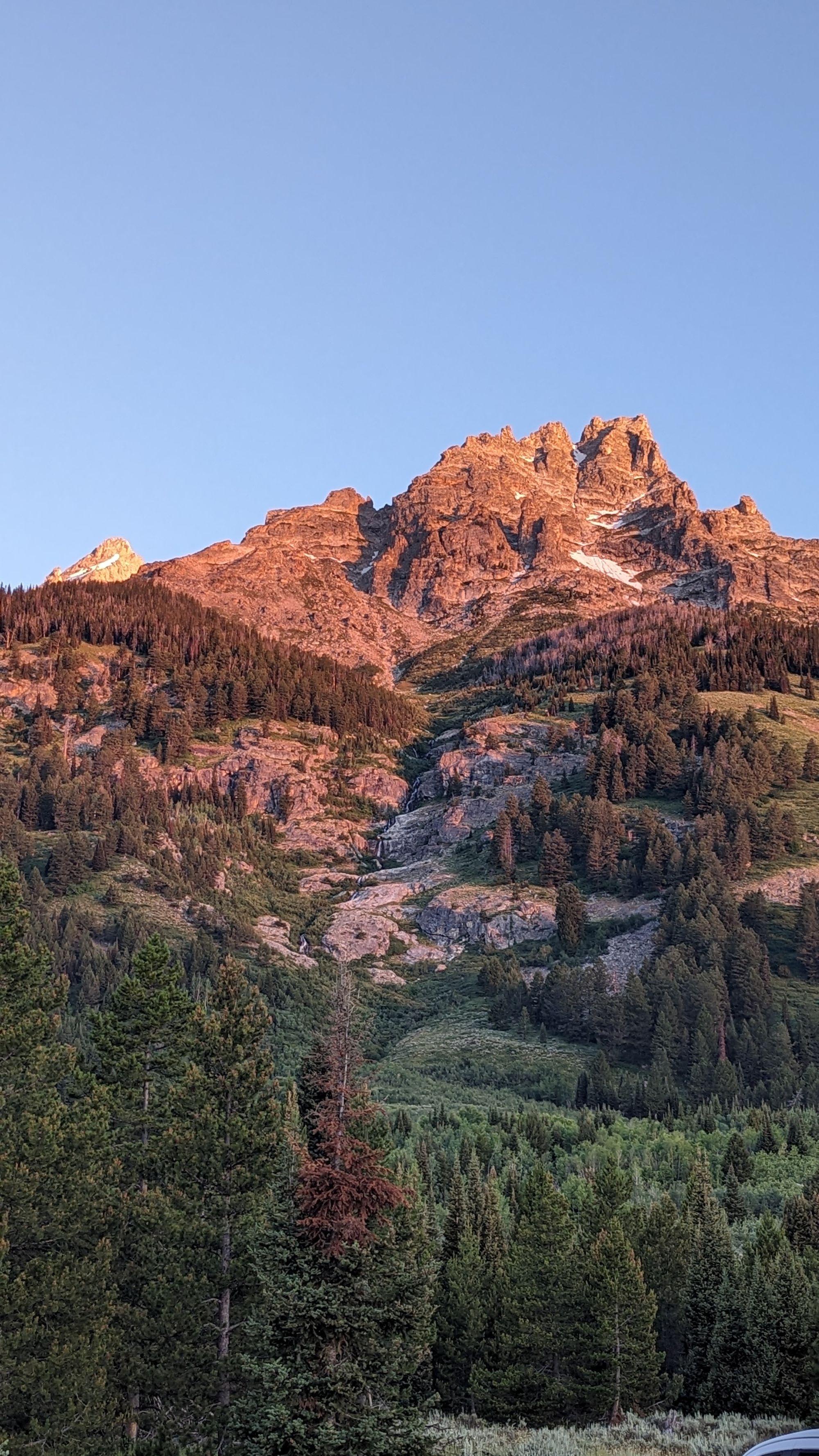
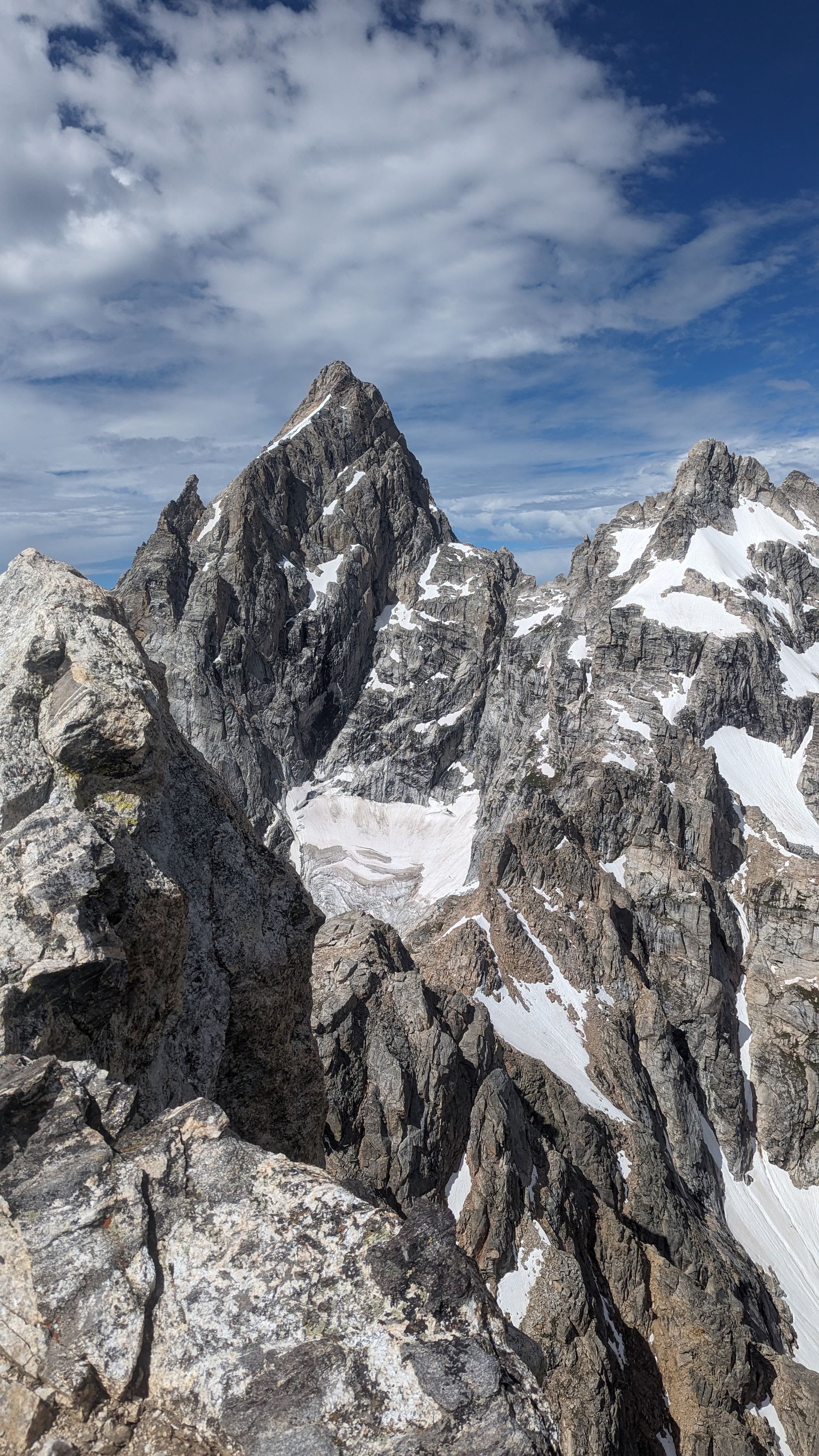
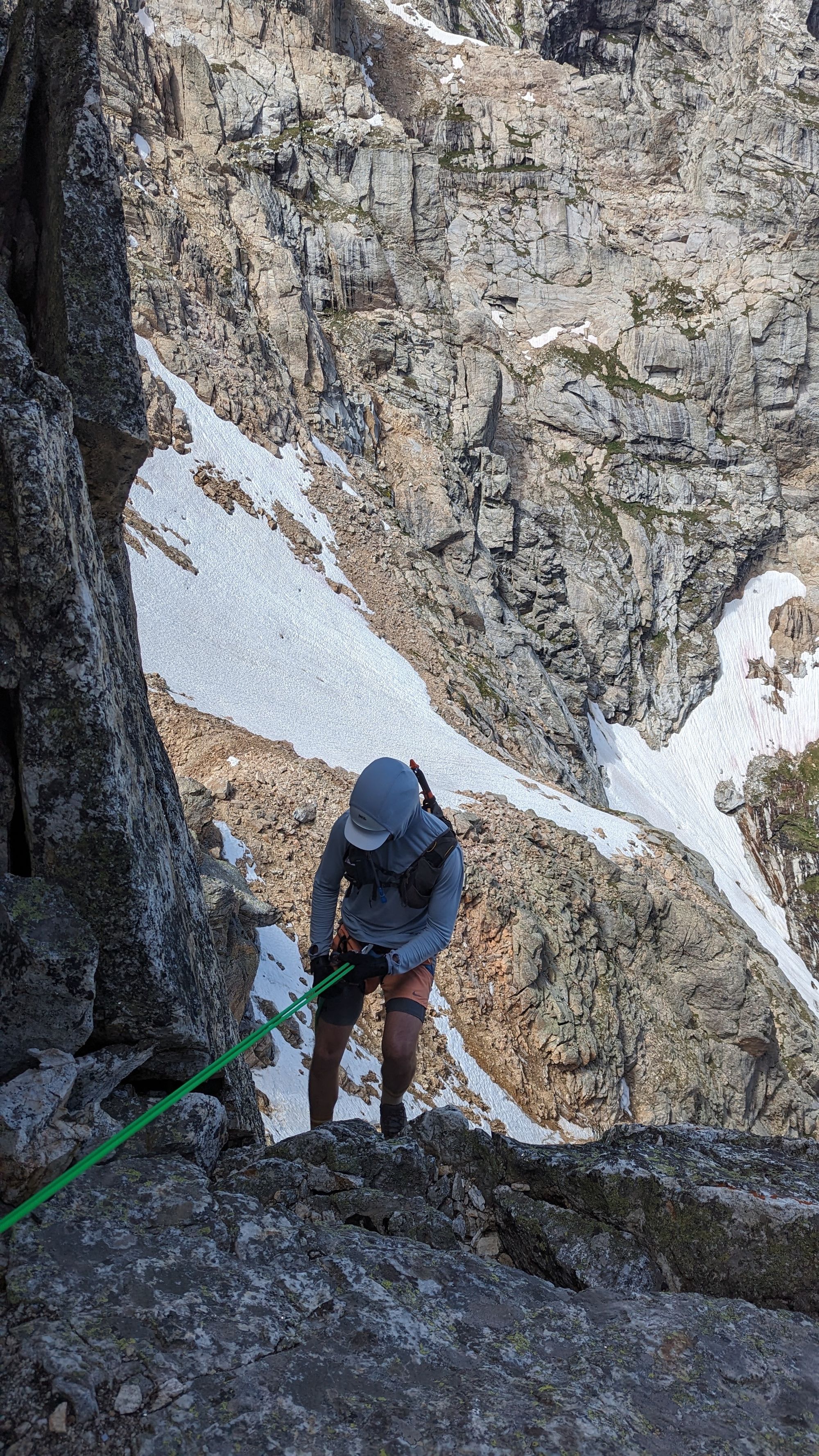
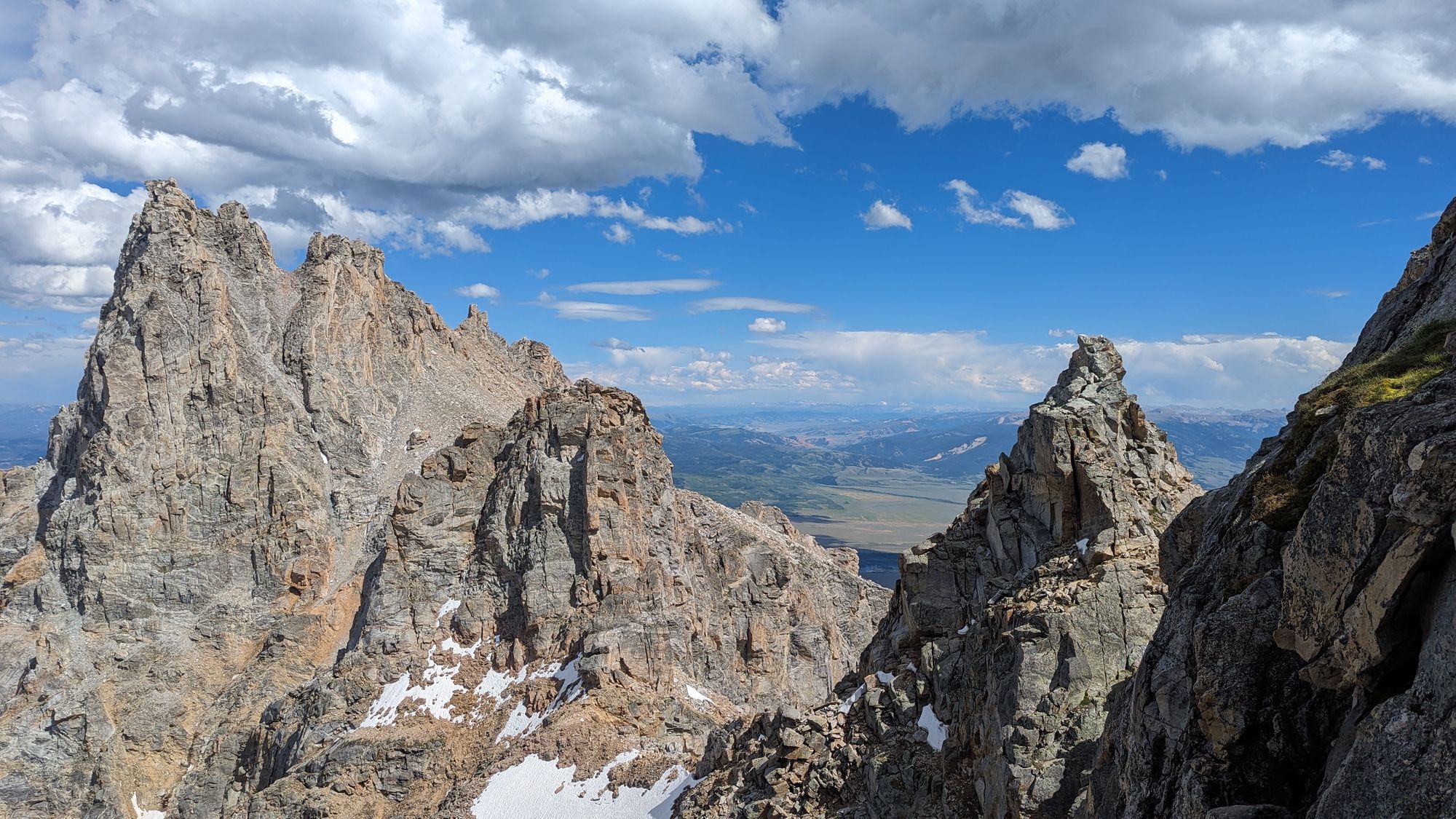
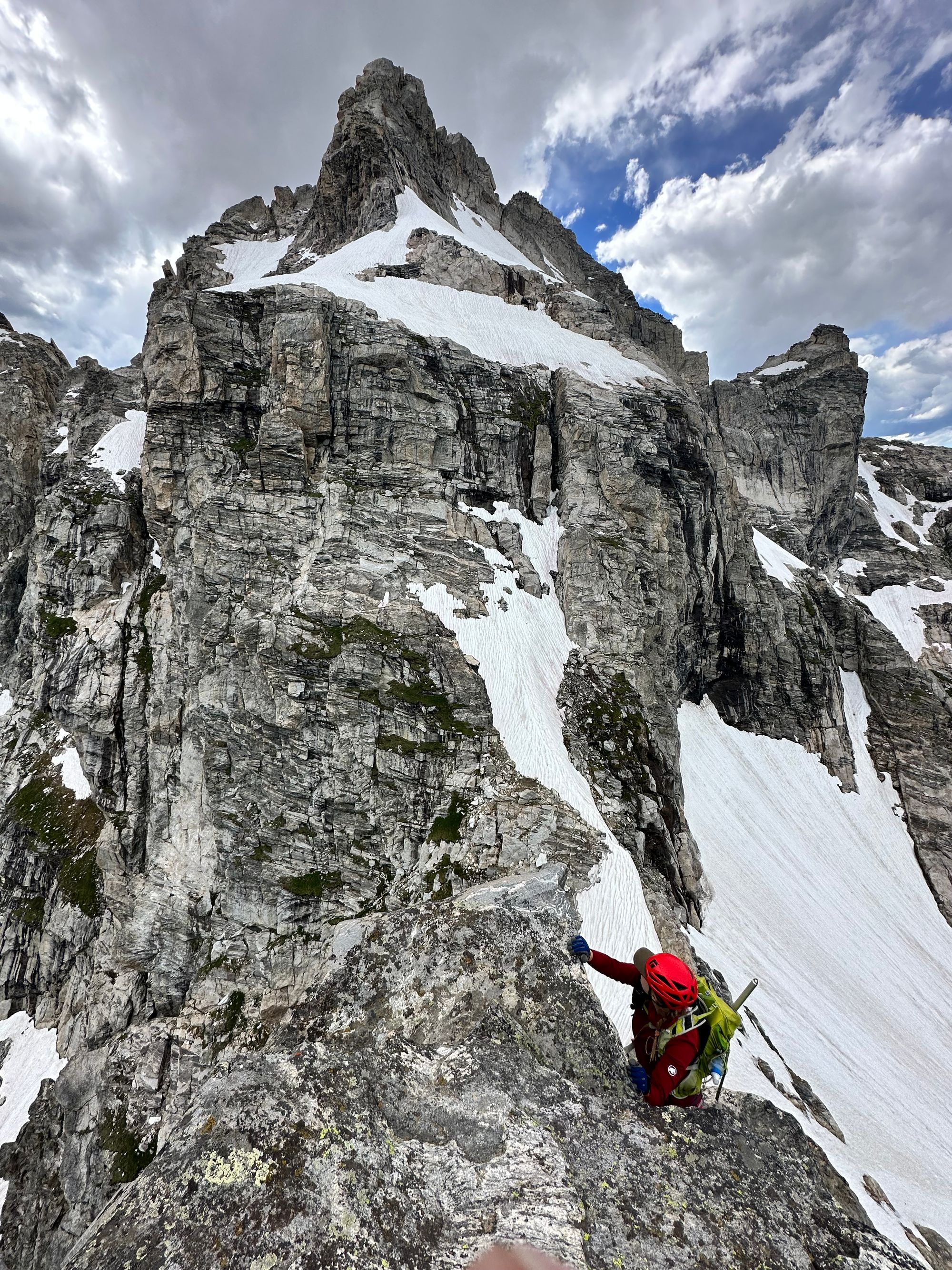
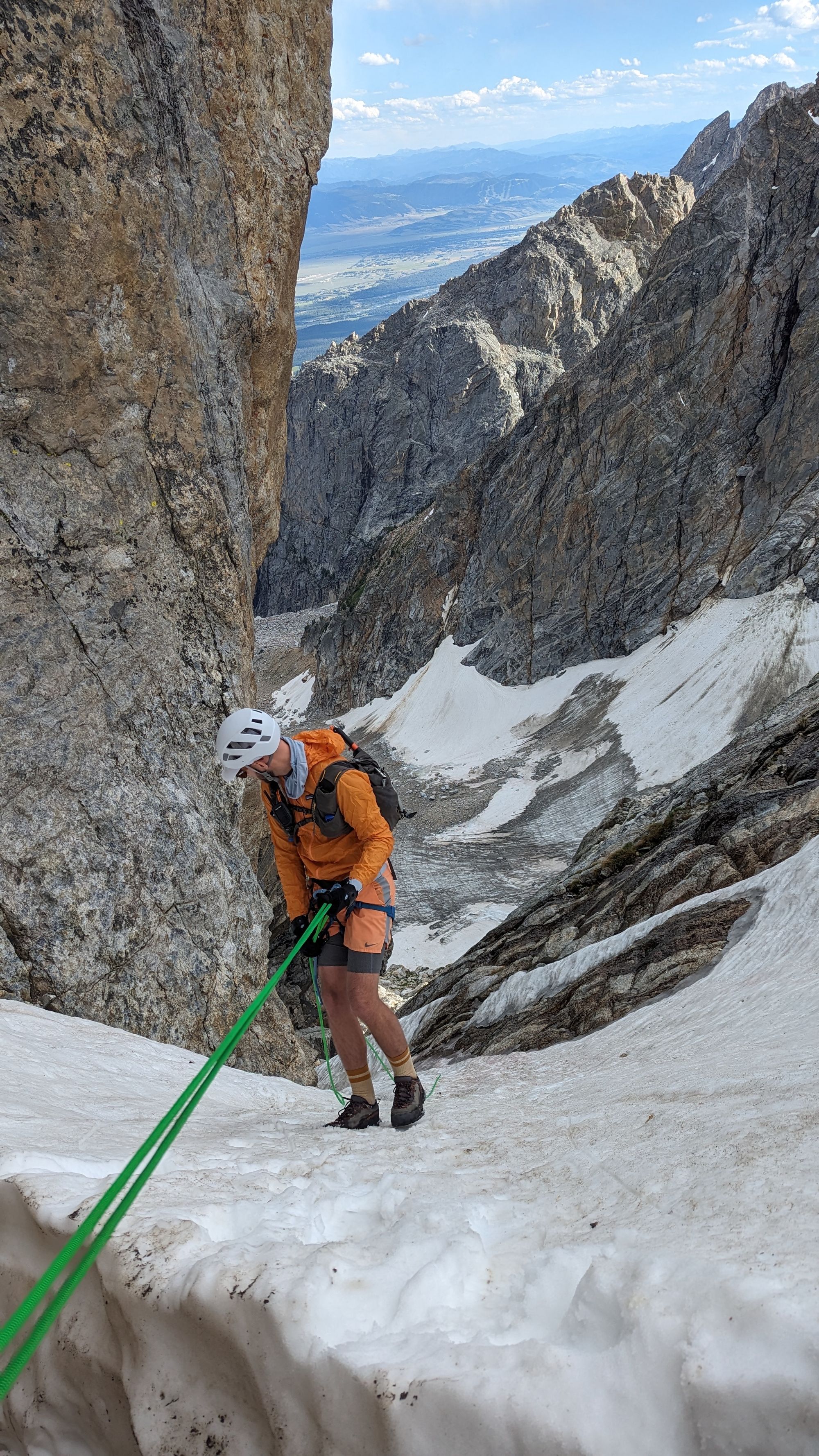
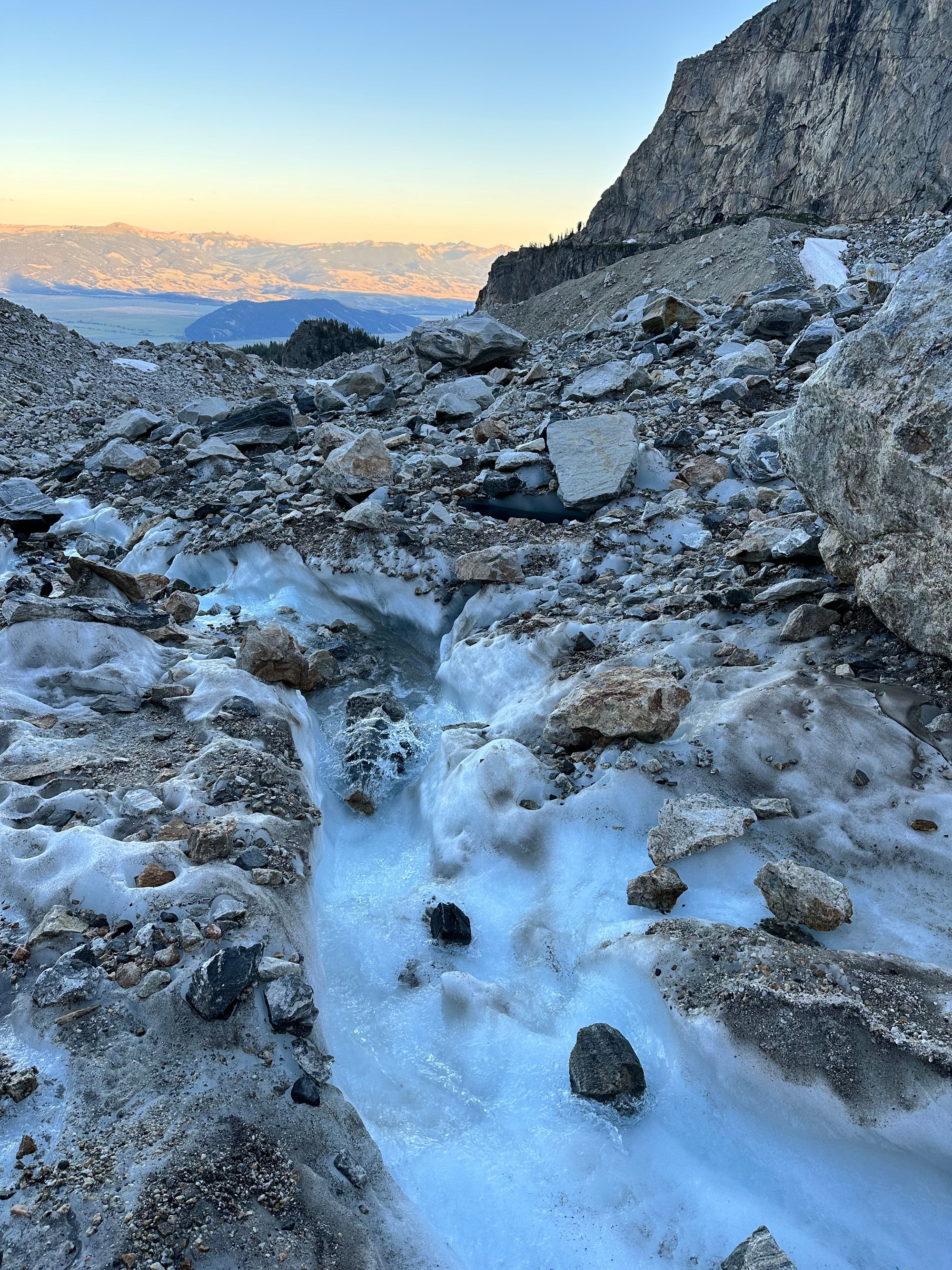
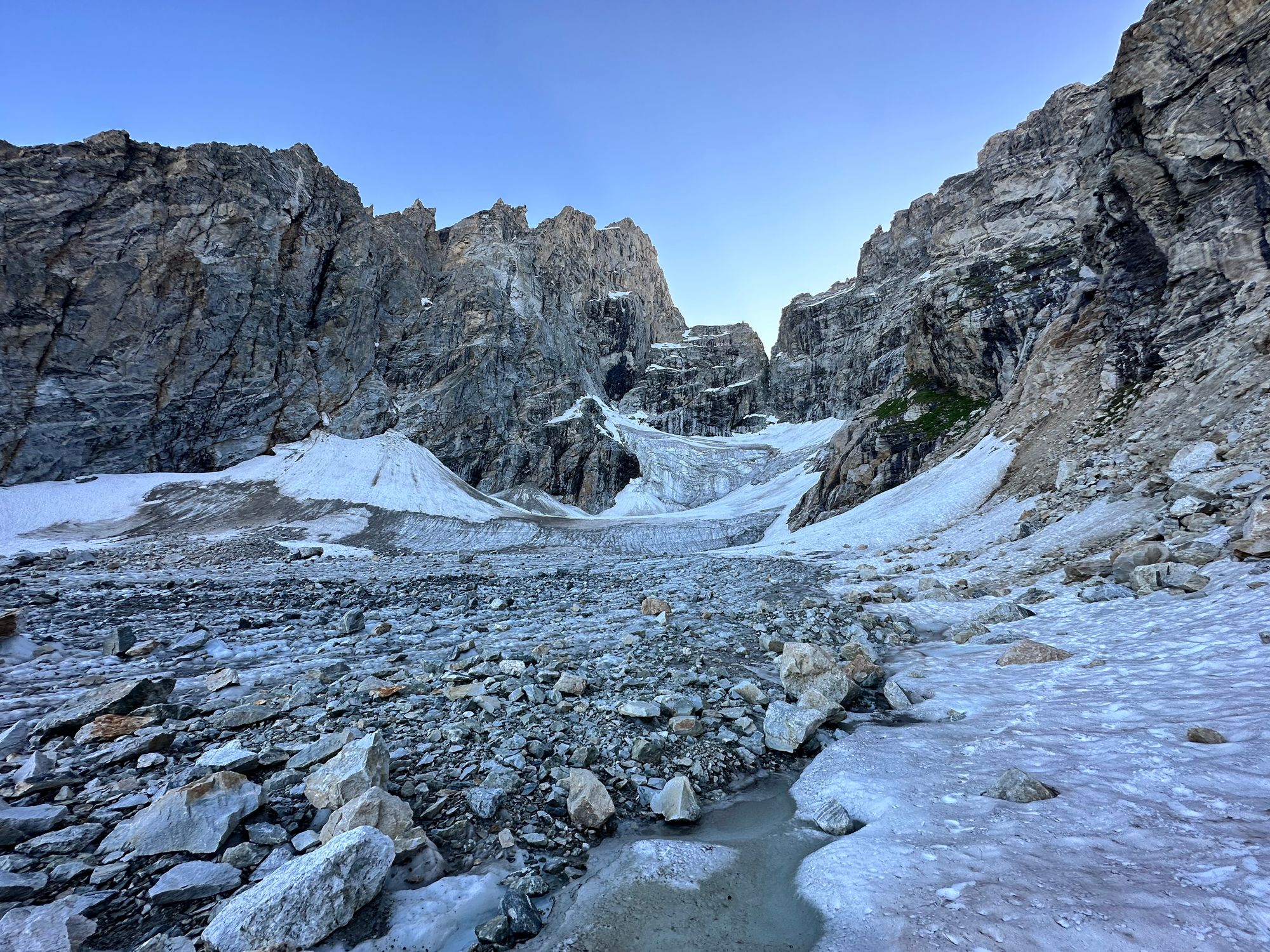
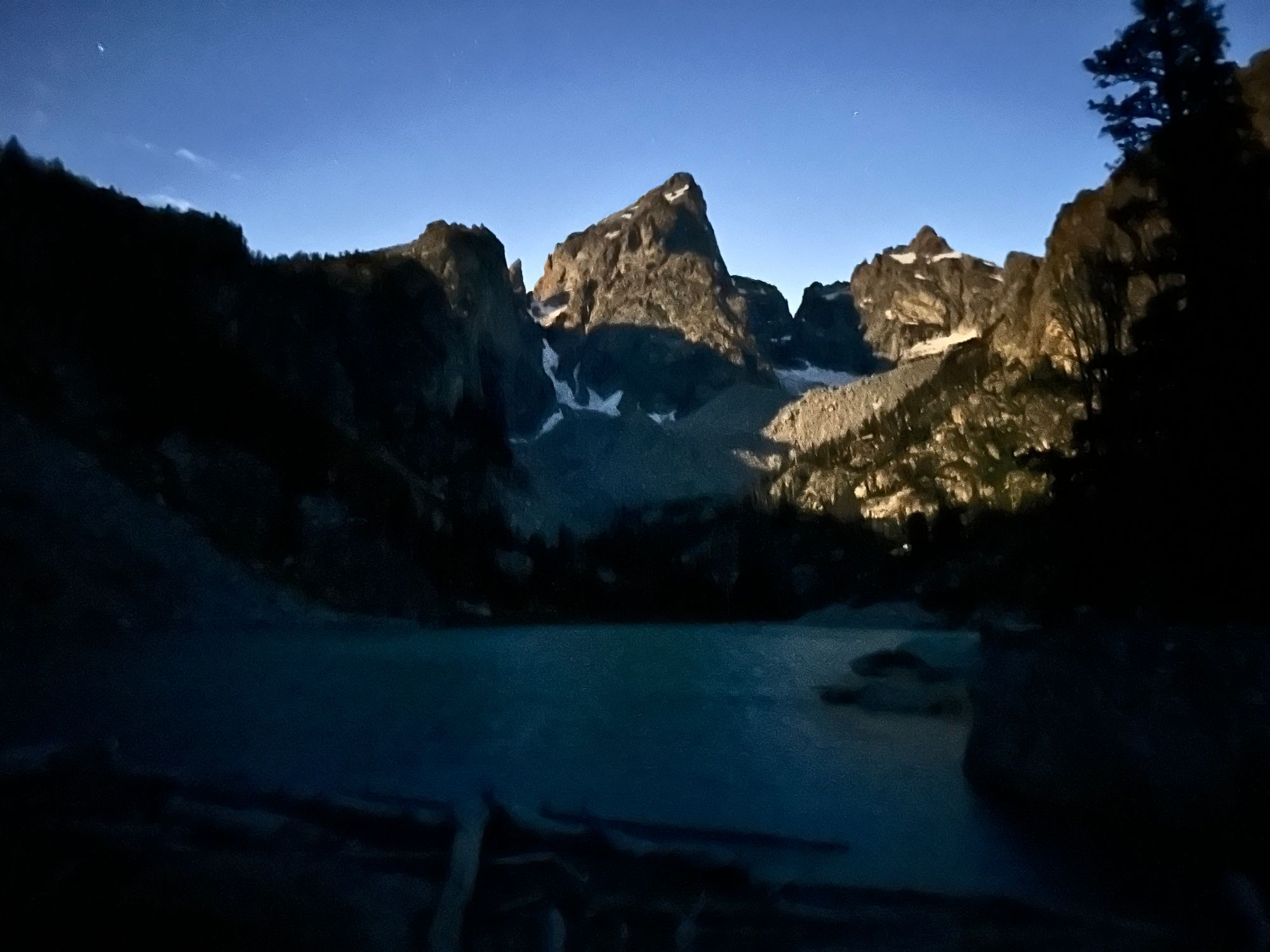
Stages of Teewinot to East Prong
We planned a similar scouting mission of South Teton to Nez Perce and Middle Teton from the north. Then, a relentless wave of storms pounded the Tetons.
In late July, Connor and I connected with Jack Kuenzle to coordinate spotters for his Grand Teton FKT attempt, hoping to avoid traffic jams at Belly Roll, Fixed Rope, etc. Storms put his attempt on hold for a couple weeks. He finally got a narrow weather window, but missed the record by 9 minutes at ~3:02 trailhead-to-trailhead. Right after Jack drove east, another wave of storms hit the Tetons, depositing even more ice and snow.
Running low on time, we opted to skip the scouting missions and go for the Grand Traverse with the next weather window. Connor and I rotated between our Ford Stettner crew to CMC Face to just us, as windows and injuries knocked partners out of commission. Once, we went so far as to cache gear at the Lower Saddle and set 11pm alarms. But, a head cold, fatigue / injury from another mission or weather kept derailing plans. We'd approach (and maybe exceed) our limits on the Grand Traverse, so we wanted the full group near 100%.
In the meantime, I hit some sport routes in Teton Canyon and the Driggs gym, frequented the Snow King bouldering wall and studied systems. I led a group of five up Grand Teton's Owen Spalding, narrowly surviving a run-in with an afternoon thunderstorm, sheltering from hail near Sargent's Rappel.
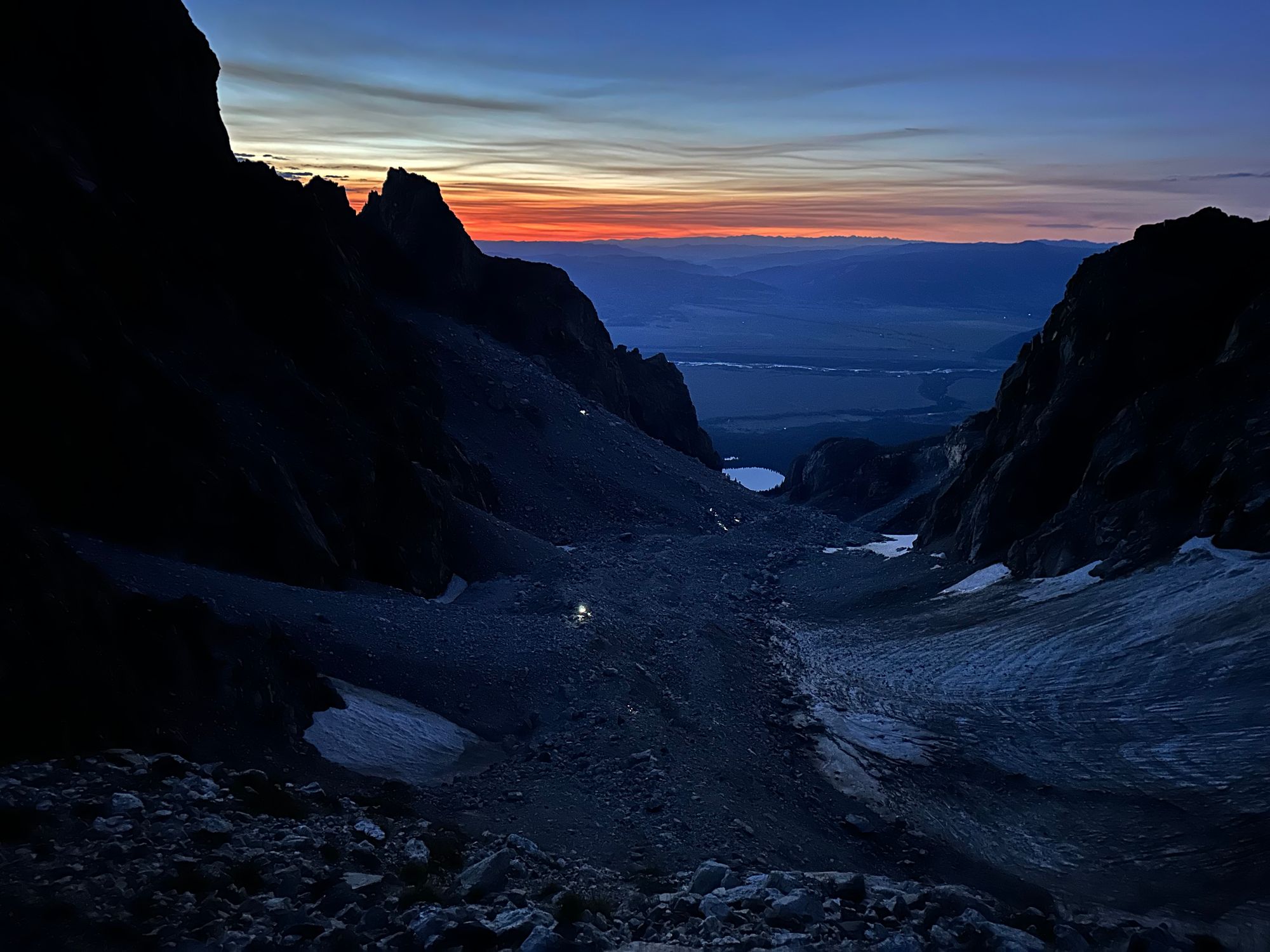
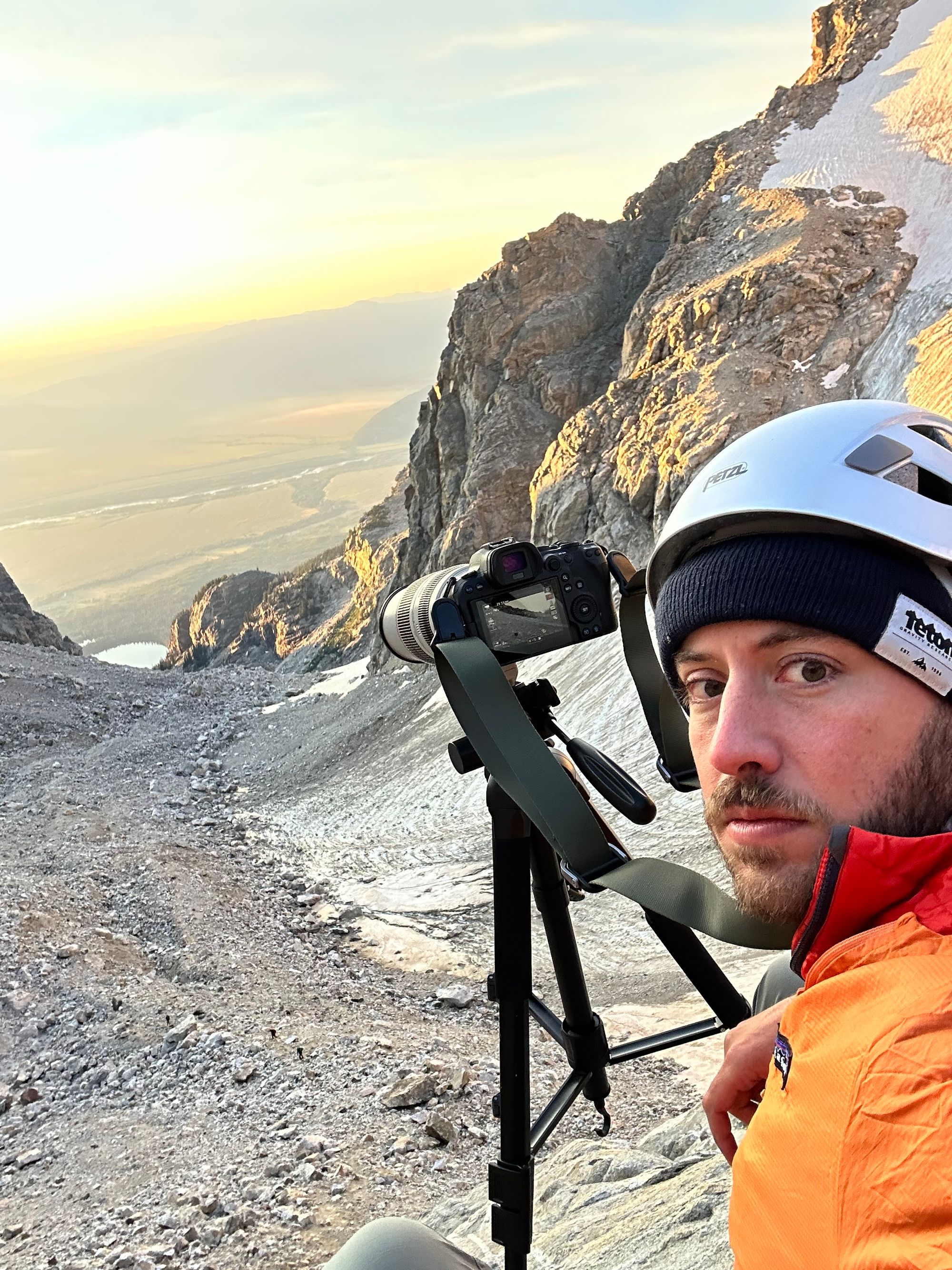
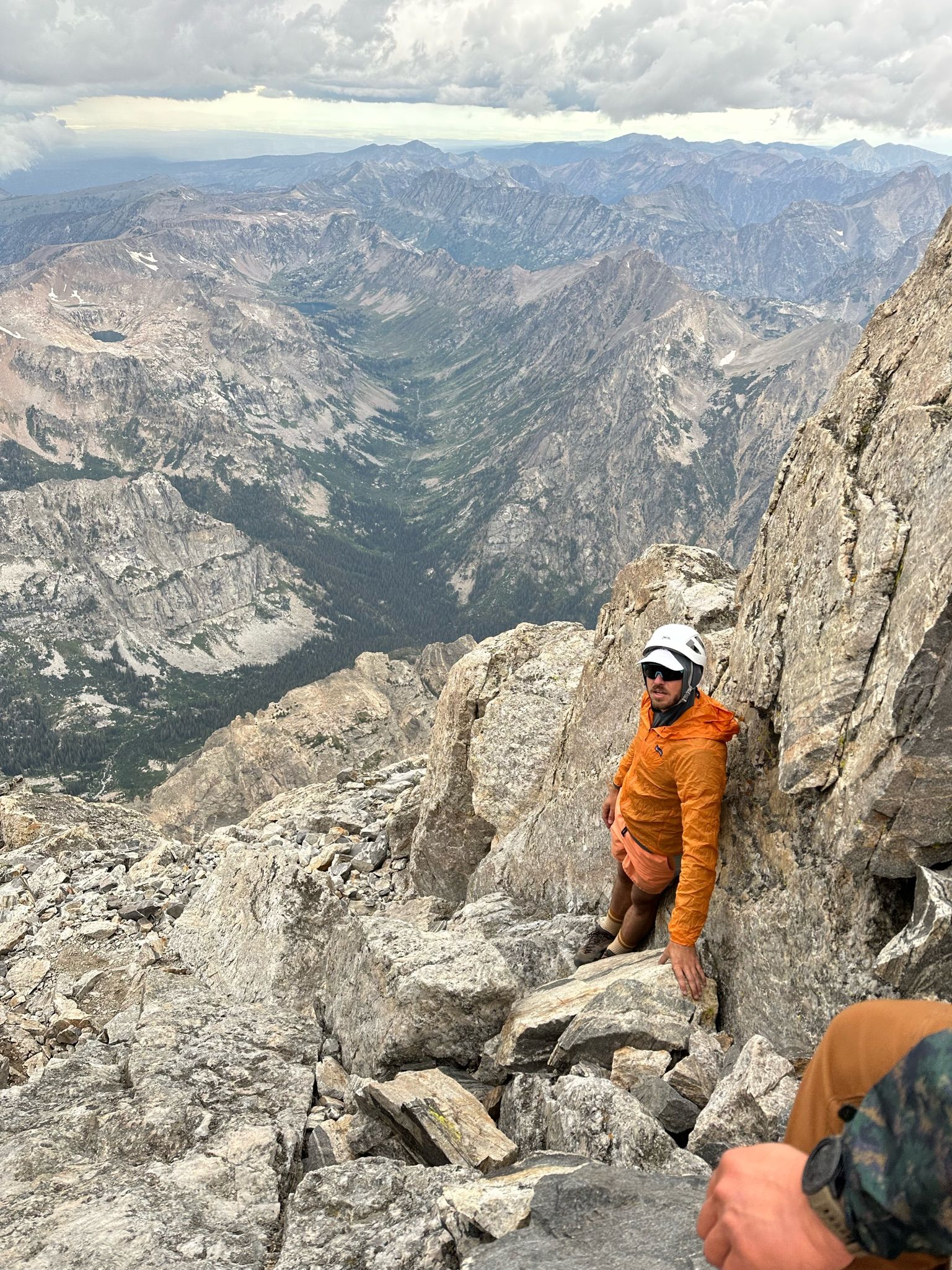
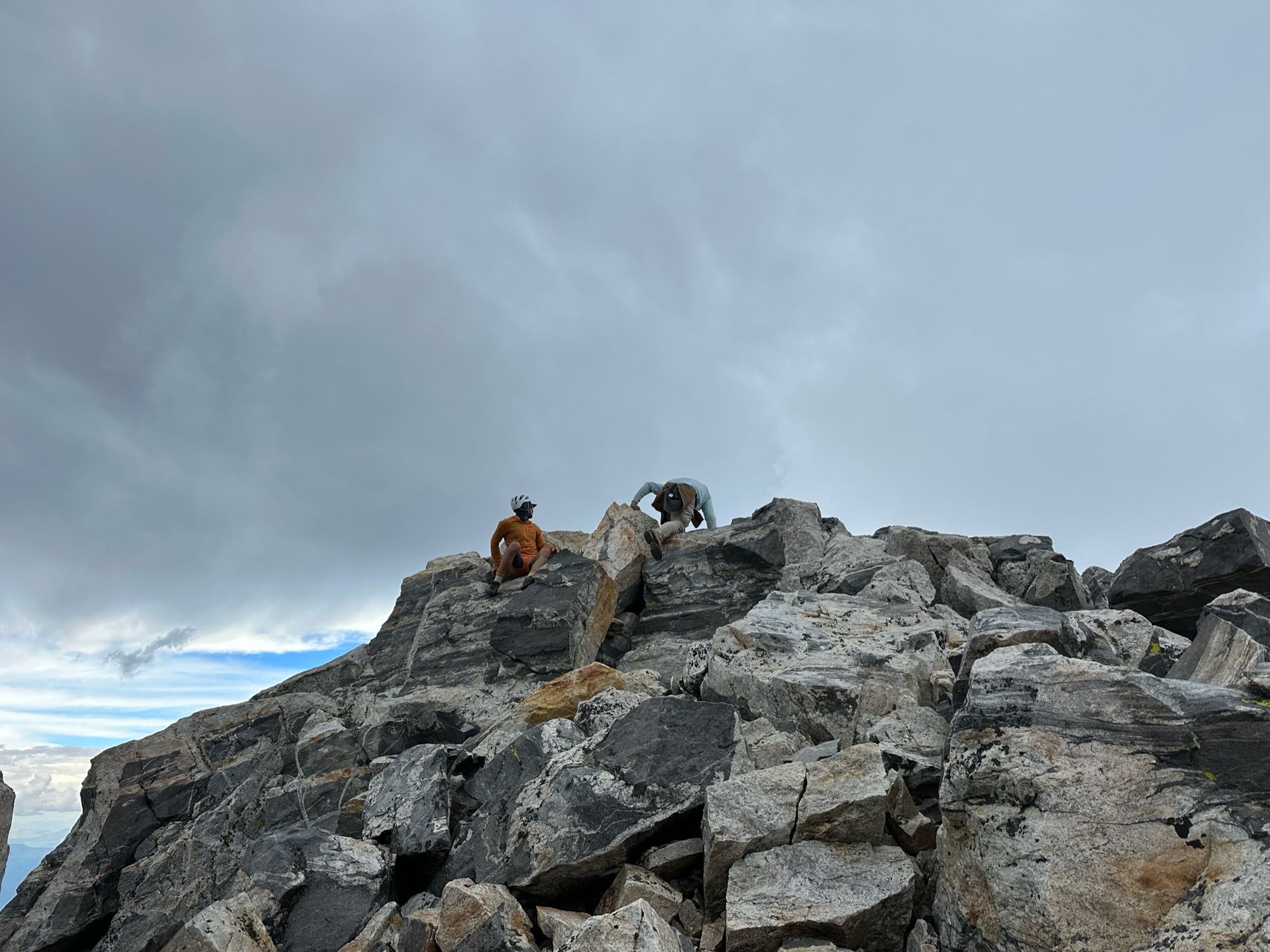
Grand Teton during Jack's FKT attempt and our thunderstorm climb
Before we knew it, September arrived and still no big climbing objectives. Pingora's East Face in the Wind River Range made the list thanks to the Takeuchi sisters, Kelsey and Brigette. Pingora would be a good test for the Grand Traverse, specifically for the 7-pitch, 5.8 North Ridge of Grand Teton. We were hoping a high-pressure system the following week would be our window for the Traverse.
After we drove the hour and a half to Pinedale, we spotted 2am thunderstorms on Windy. I planned to bivy and the others skipped tent flies. Pingora was an 11-pitch climb, so we'd need to start near sunrise. Combined with a 10-mile approach, we wanted to overnight near the route.
Due to the thunderstorms, we opted to sleep in my truck at the trailhead, then try a less committing climb with a shorter approach. Unfortunately, a cruxy offwidth and blustering winds at the start turned us around.




Turned around in the Winds
The "clear" forecast that week, consistently <10% chance of rain, somehow produced consistent afternoon thunderstorms in the mountains. The storms alternated between the Tetons, Snake River Range, Wyoming Range and Winds.
After our turnaround in the Winds and consistent storms, we gave up on the Grand Traverse for 2023. We assumed ice had formed in cracks on north faces, bumping up challenging cracks and slabs to a hair-raising mixed climb.
Feeling defeated, Connor and I spotted one more weather window, starting Thursday the 14th. A few days of morning sun should dry Pingora's East Face. We landed on a Sunday afternoon approach and overnight, then Monday climb. Scattered rain showers would start Monday night, then a storm on Tuesday.
Big Rock
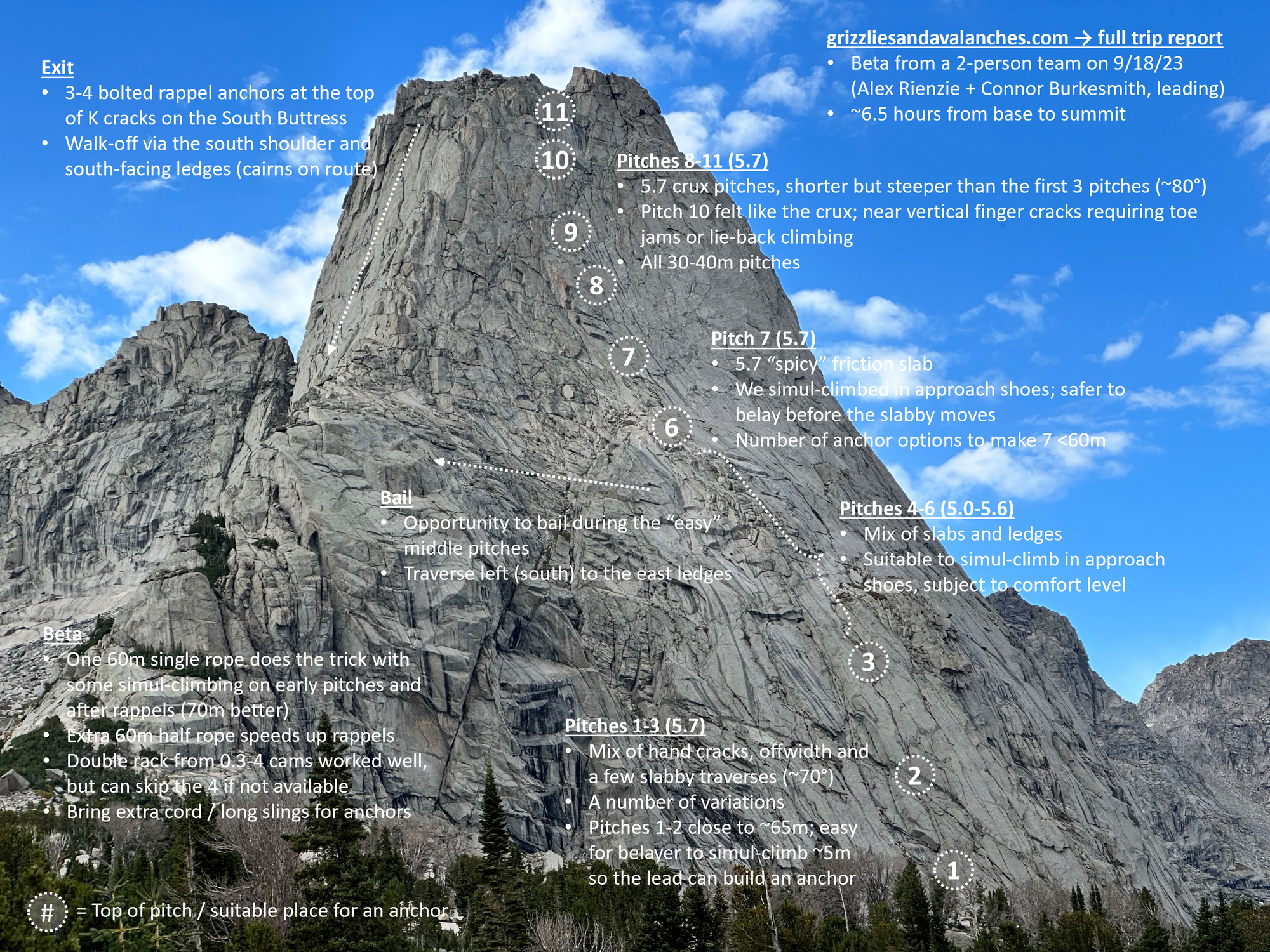
Beta
- We overnighted beneath Cirque of the Towers to avoid the 10-mile approach before 11 pitches; good call considering fatigue at the summit
- The route starts with challenging (but true 5.7) hand cracks and offwidth at 60-70 degrees, requiring ~10m of simul-climbing with a 60m rope
- We simul-climbed the middle pitches (5.0-5.6) in 40 minutes, placing a cam or two between us to arrest an unlikely fall
- The final 4 pitches were the crux, steeper than the beginning pitches with a number of cracks closer to 70-80 degrees
- On a couple pitches, Connor placed almost all our cams from 0.3 to 4; we're new to crack climbing and he was liberal with protection; but given the number of "rope stretcher" pitches, I'd recommend a double rack (could skip 4s)
- After a final summit scramble, we easily found the rappel bolts at the top of the South Buttress starting above K Cracks (3-4 stations in total)
- One 60m rope is enough to rappel with some downclimbing, but we were happy to have an extra 60m half rope to reach ledges beneath the South Buttress in 2 rappels (first was a rope stretcher)
- Note: We didn't see a fourth set of bolts, but didn't look very hard
Gear
- Double rack (almost) of cams (0.3 to 4) and 60cm alpine draws
- 60-meter single rope for the pitches, plus a 60-meter half to extend rappels (note: 70 meters ideal for the beginning pitches, but some very reasonable simul-climbing bridges the gap)
- Harness, PAS (recently shifted to a lanyard), prusik, locking carabiners, ATC Guide, extra cord / long slings for anchors, a few extra wiregates, crack gloves (a lifesaver on the hand cracks), crag gloves, climbing helmet and chalk bag
- 2x Rocky Talkies (highly recommend)
- Five Ten Anasazi climbing shoes (a bit uncomfortable for multi-pitch trad) and La Sportiva TX4 approach shoes (very happy with the TX4s from Owen Spalding, the Picnic, Upper Exum, CMC Face and more, including running some downhills)
- Camping: summer-weight sleeping bag, foam sleeping pad (overdue for an inflatable), SOL Escape Lite bivy bag and an inflatable camp pillow
- Layers: Under Armour top and bottom, running shorts, sun hoodie, fleece, puffer, windbreaker, extra wool socks (thin pair for climbing shoes), ball cap, beanie and lightweight gloves
- Food: Goldfish (flavor-blasted), GU gels, Clif bloks, assorted bars (e.g., Kate's and PROBARs), Justin's nut-butter packets, plus an extra cold brew and Goldfish bag in the truck to power the 3-hour drive home
- Water: Katadyn 1L filtered water bottle, 0.5L running water bottle (refilled with Katadyn) and Pedialyte electrolyte packets
- Emergency / other gear: sunglasses, LED headlamp, first-aid kit, moleskins, tourniquet, fire-starter (limited dry leaves / grass, so used one block), lighter, space blankets and handwarmers, Leatherman multi-tool and ibuprofen (popped a few during the climb to survive toe jams)
- 40L backpack
Night Hike to the Bivy Boulder
Sunday morning, I woke up nursing a hangover from the TGR film premiere. Connor drove from Driggs to Jackson to carpool 3 hours to the Big Sandy trailhead. He arrived at 1pm, we organized gear, then headed to Teton Mountaineering for cords and Albertson for more food.
At 2:30pm, we hit the road, stopping for more food at Pinedale's Ridley's. We reached Big Sandy trailhead at 6pm, finished packing and started hiking east. It was a Sunday night at 6:30pm. All the traffic on the access road and trail was going in the opposite direction.
We made good time, reaching Big Sandy Lake at ~7:45pm and starting the switchbacks leading to Jackass Pass at ~8:15pm.

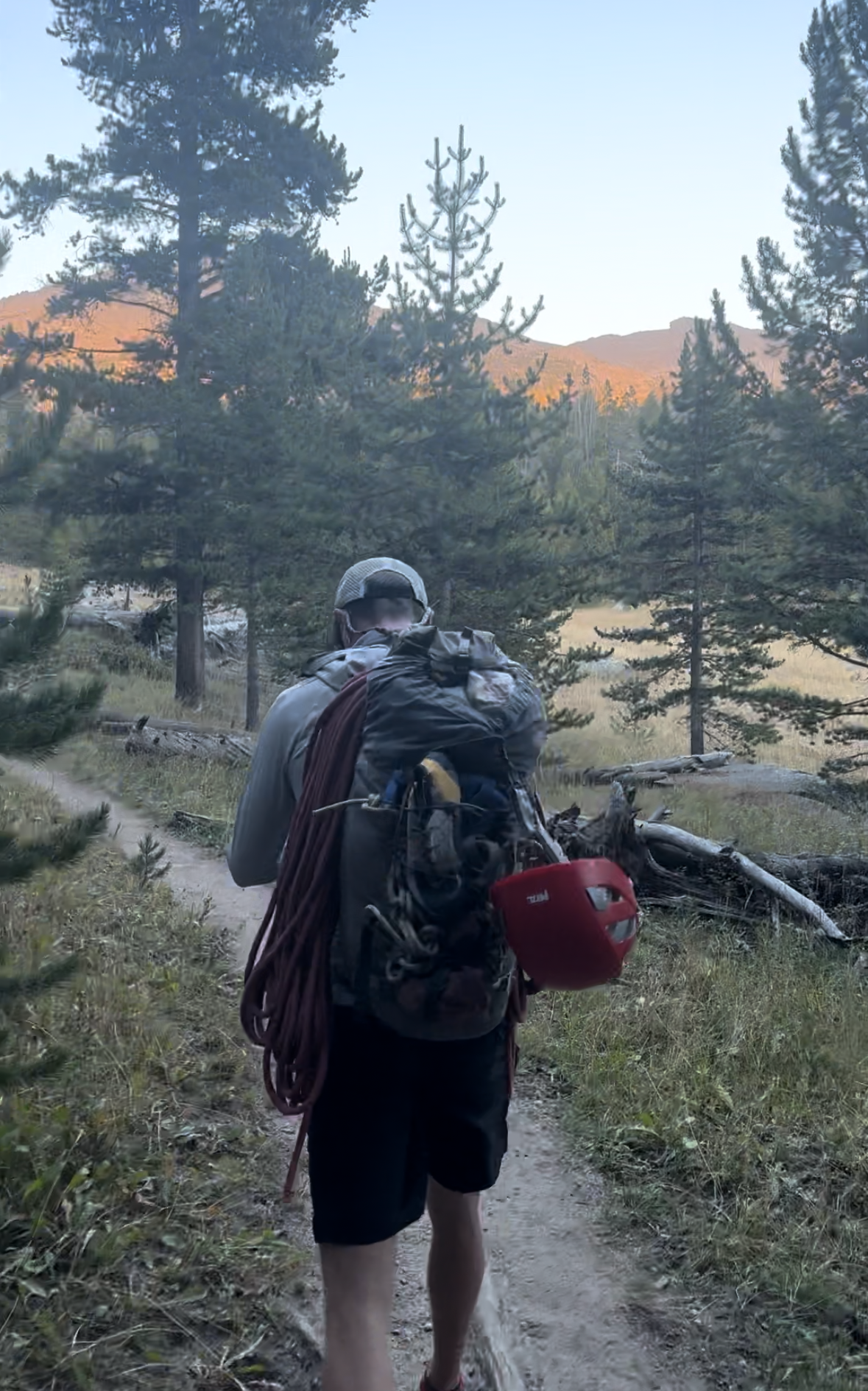



Trailhead to Big Sandy Lake
By 9pm, we meandered through the boulder fields above Arrowhead Lake. Connor posed next few house-sized boulders. The cliffs above blended into the dark sky.
At 9:30pm, we descended from Jackass Pass into the meadows to search for a bivy site. We picked up some downed, dead wood along the way, hoping a small fire would heat up the granite and keep animals away.




Boulder fields above Arrowhead Lake (and the Big Dipper)
After ~20 minutes scouting boulders, we picked one with a large overhang and a small firepit in its back corner. Connor refilled his water bladder. I added my base layers, fleece and puffer. We pulled out sleeping bags, bivy sacks and pads.
I worked on the fire, ultimately resorting to a fire-starter block, low on dry grass and leaves. (It was wet summer.)
By 10:30pm the fire roared, lighting the boulder and bushes in an orange glow. Unfortunately the boulder had a wind tunnel, a few times filling our "cave" with smoke and sending embers uncomfortably close to our sleeping bags.
By 11pm the fire settled down and I laid down. At midnight, Connor woke to rustling in his pack and shook out a mouse. At 2am, that mouse (or its friend) found Goldfish strapped to the outside of my pack. I heard nibbling and moved the bag inside my pack, then the pack to a safer spot. I watched the mouse scamper into the bushes.





Bivy boulder, below the tree line
After a night of tossing and turning, Connor's alarm rang out at 6:30am. Wrapped up in a warm sleeping bag, I snoozed another 15 minutes, while Connor topped up his water bladder. By 7am, we rolled sleeping bags and pads in our bivy sacks, stashed in a nook on the boulder.
The sun reached the summits of surrounding peaks, an orange glow creeping toward the meadows below. I neglected to refill my bottles at night and felt dehydrated, so I drank a liter of water and refilled my extra bottle with the Katadyn, while Connor finished reorganizing.


Sunrise reached Pingora's summit, as we broke camp
By 7:30am, we hiked north to the base of Pingora. We crossed a stream pouring over a granite dam, hiked through brush and over boulders beneath Pingora's south shoulder. We paused for a bathroom break and stream refill. Cold alpine water kicked my hypothalamus into overdrive. I filled 1.5L for the climb, adding electrolytes to the 0.5L bottle.
The summits of the Cirque glowed yellow, now fully embraced by the morning sun. We passed a couple tents and a group of 4 headed toward the Cirque. As the sun reached the meadows, I ditched my puffer.

At 8:30am, we found the start of the route, at first overshooting by ~100 feet. Just north of a small snowfield, there's a ~50-foot wide block of granite that protrudes from the base of the East Face. The route starts on one of the cracks toward its right side with a number of viable 5.7 variations.
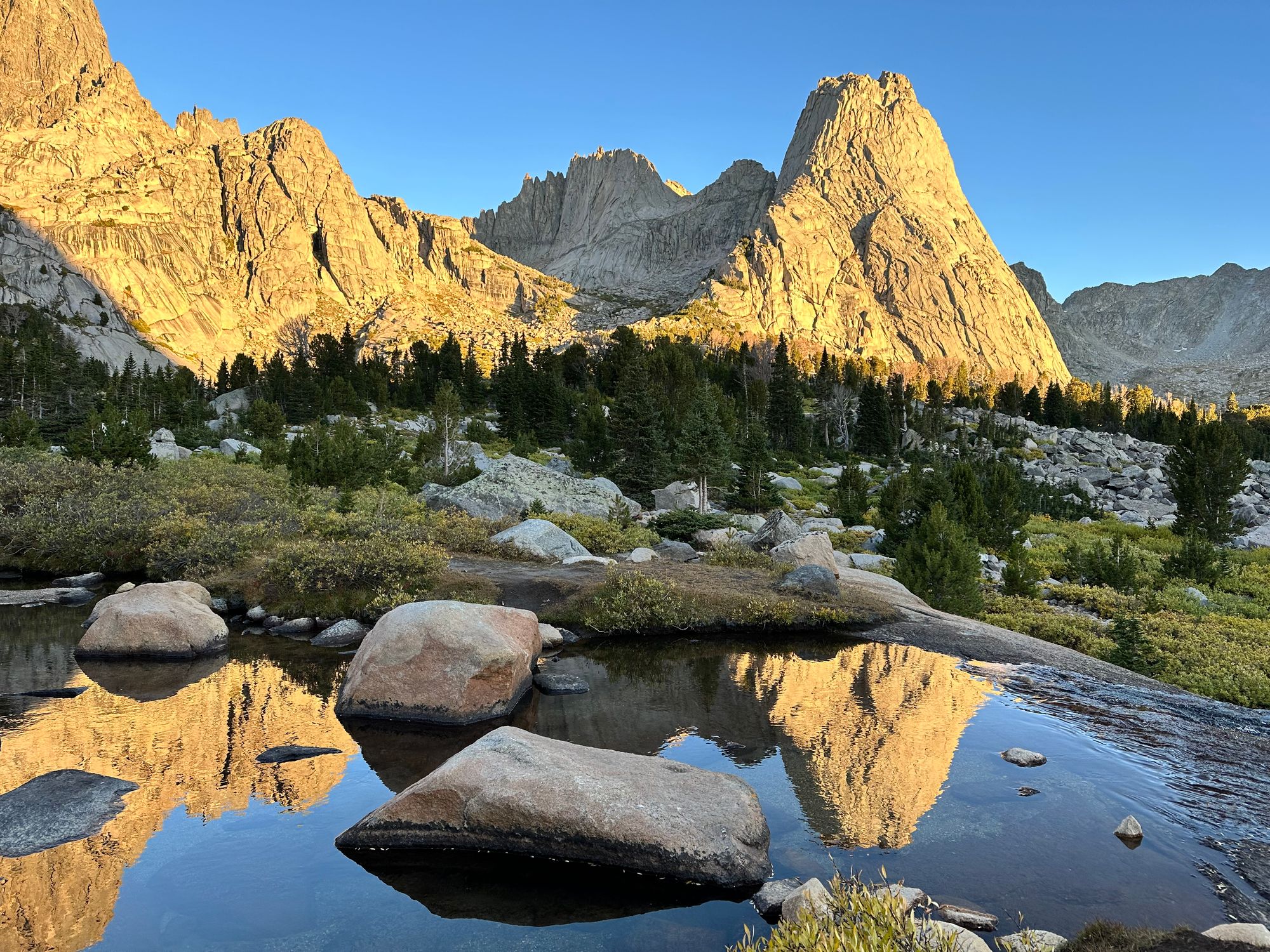


Approaching the base of Pingora's East Face
Expecting painful toe jams, I popped a couple ibuprofen.
Note: Credit to this Mountain Project mark-up for pitch lengths. We triangulated from a few sources, but mostly followed pitches as laid out there.
Pitches 1-3: Finally an Honest Trad Rating
175m at 40min per pitch
Pitch 1 (5.7 | 65m | 50min)
We stumbled into harness, organized cams, flaked the single rope, velcroed crack gloves and tied figure 8s. Standing in the morning sun with no wind, I traded my fleece for a sun hoodie, but kept the base layers.
At 9am, Connor started leading pitch one, as I belayed. I kept our half rope and Connor's approach shoes to balance the weight.
Connor troubleshooted an awkward offwidth move at the start, then worked up a mix of hand cracks and offwidth. He came within 5-10m of a ledge to our left when we ran out of rope.
I started simul-climbing to the first awkward offwidth, at which point Connor reached a suitable anchor location. At 9:25am, he called over the Rocky Talkies.
I followed Connor's route in 15 minutes, meandering between cracks and one traverse half-way. I removed cams, clipping them to my gear loops. I noticed a few other 5.7 variations to the left and right. Pingora was my first multi-pitch 5.7, so I was relieved to cruise up the first pitch.
At the top of the pitch, I found Connor belaying from a slung boulder a ~meter above the start of the ledge. He was just left of a south-facing corner and ~5 meters beneath a large roof capping the corner.
We troubleshooted the start of the next pitch from Mountain Project mark-ups (credit: Jason Todd and Blitzo). We opted to climb right, up the south-facing corner just before it topped out at the roof above us.
By 9:50am, clove hitched into the anchor, I loosened my climbing shoes, flaked the rope and belayed Connor. We were nervous about pace, now relieved to kick off the climb at 45-50 minutes for one of its longer pitches.






Stages of pitch 1: start (top) to anchor looking up at pitch 2 (bottom right)
Pitch 2 (5.7 | 65m | 35min)
Connor cruised up pitch 2, nearing a ledge system at 10am. I simul-climbed ~5m to just below the roof, which gave Connor enough slack to build an anchor.
As Connor built the anchor, I watched a pika navigating the boulders at the base of the East Face, mouth full of grass, caching for the winter. A hawk circled above. Another pika stood watch. Planet Earth, live, but no casualties that morning.
By 10:10am, Connor built the anchor for pitch 2 and I started climbing. Pitch 2 was similar to pitch 1, maybe a bit less offwidth. I reached the ledges just below Connor's anchor at 10:25am and we transitioned for pitch 3.





Stages of pitch 2
Pitch 3 (5.7 | 55m | 35min)
We cruised up pitch 3 in ~35 minutes, reaching the start of the easier climbing by 11am. Connor reached ledges at the top of pitch 3 with an extra 5m of rope and slung a large horn as an anchor. Our toes were already killing us.
Of pitches 1-3, Connor thought 1 was the hardest. I thought that honor belonged to 3. Foot size might explain the debate. My big feet jammed into the top of the cracks on pitch 1, while Connor's occasionally punched through, slowing him down. On pitch 3, my big feet barely jammed into the narrower cracks.
Either way, the first 3 pitches felt like true 5.7s, a pleasant surprise after our experience with sandbagging in the Tetons and Winds. We averaged 40 minutes per pitch on the bottom 3. At the base of pitch 4, we refueled on bars, peanut butter packets and Connor's Chex mix.



Stages of pitch 3 (only the top)
Pitches 4-7: Simul-Cruising + Spicy Slab
~255m at 10min per pitch
Pitches 4-6 (5.0-5.6 | ~185m | 30min)
The granite flattened to 40-50 degrees ahead, so we switched to approach shoes. Our toes thanked us. We coiled ~35 meters of rope around our chests, split between us. At 11am, Connor climbed, ~25 meters of rope as a head start.
I left the sling in place until Connor placed the first cam. Once the rope neared its limit, I cleaned the anchor and climbed.
Connor and I cruised up the next 3 pitches, pausing periodically so Connor could place a cam when I reached the lowest. As we climbed, we spotted a series of ledges to the left leading to the south shoulder, the first bail opportunity.
The wall gradually steepened to ~60 degrees and features faded.
Pitch 7 (5.7 | 70m | 10min)
Before long, the features faded to divots. Connor climbed a bit too far left, then traversed right over a slab to place a cam. We inadvertently simul-climbed the 5.7 "spicy friction" pitch in approach shoes. Pushing our limit, Connor placed another cam and belayed me for the last ~20 meters of pitch 7.
I followed his path left, then traversed right via a couple shallow divots in the granite. Connor was 5-10 meters to my right. If my approach shoes slipped, I'd bounce 7-15 meters over the granite before he caught me. I made it across safely, but in retrospect, we should've built an anchor at any number of suitable locations, before starting the "spicy friction" slab.
It was 11:35am, 40 minutes after we started simul-climbing. I transitioned to belay Connor on pitch 8, as the wall steepened. We each refueled and popped a couple more ibuprofen.
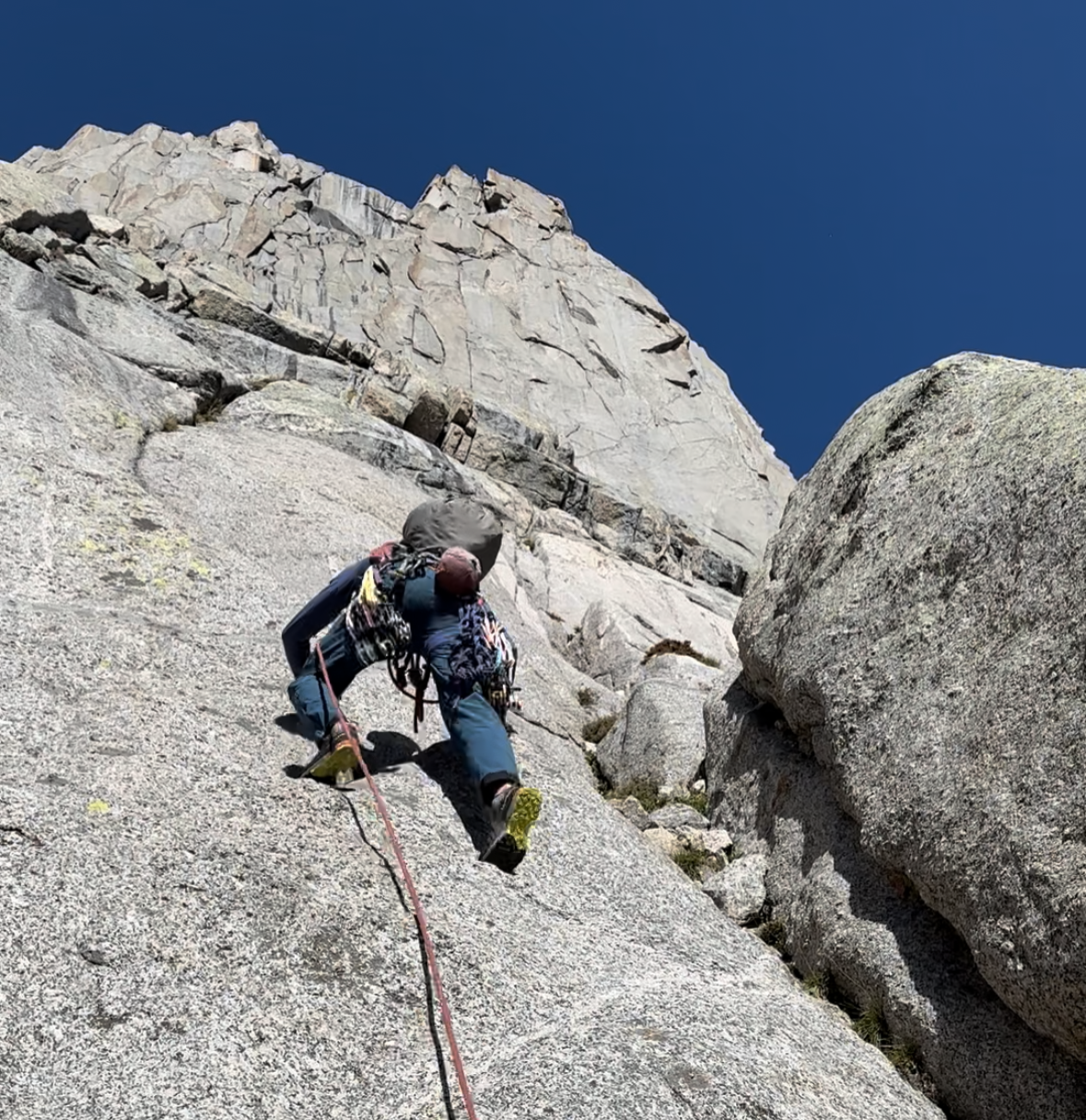
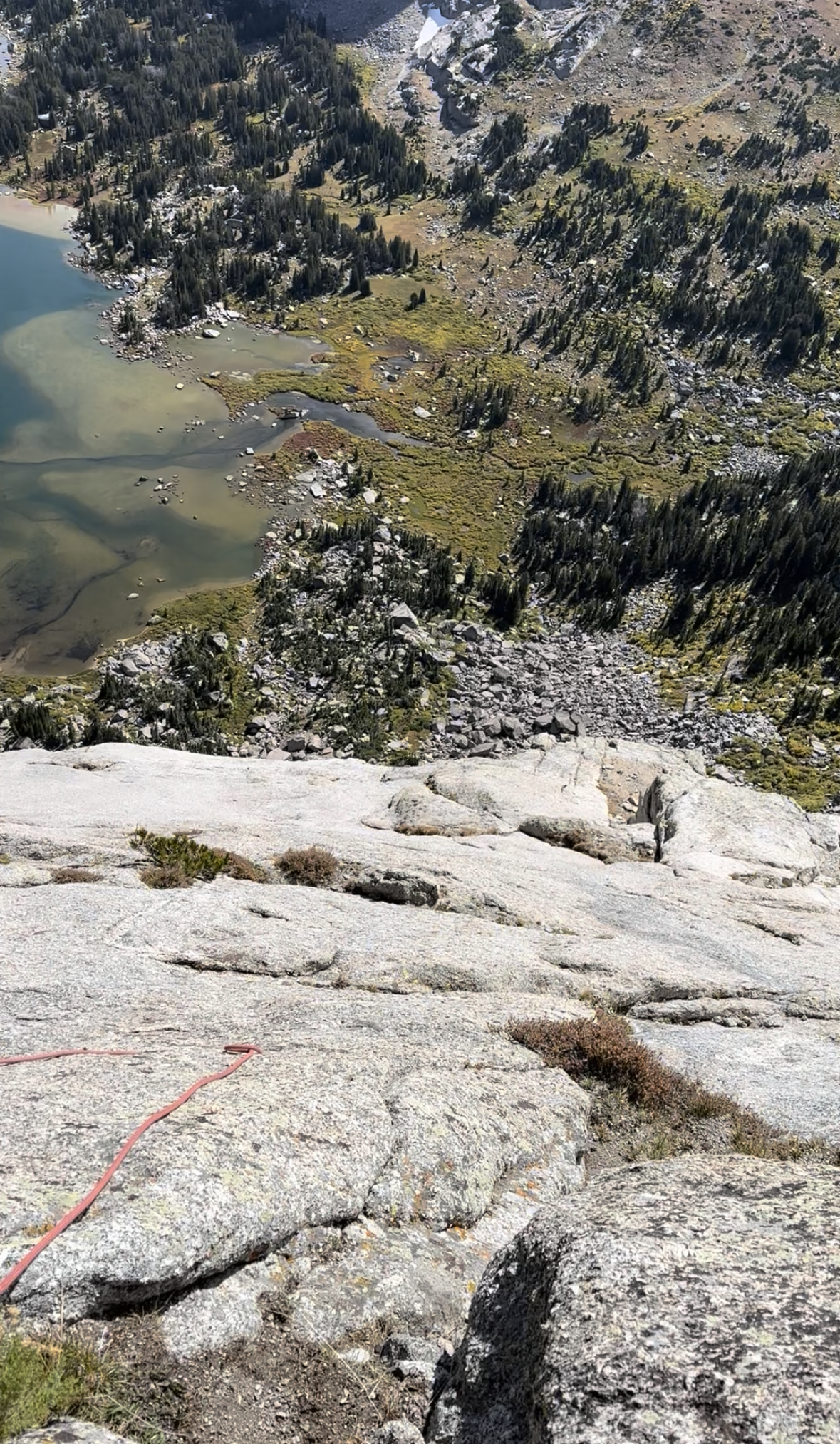
Bottom (left) and top (right) of pitches 4-7
Pitches 8-11: Save the Crux for Last
140m at 57min per pitch
Pitch 8 (5.7 | 35m | 50min)
By 11:40am, Connor climbed. The cracks were fair 5.7, but steeper than the bottom pitches. Connor took a flake variation to avoid a crack at the start. The flake turned out to be harder than the crack itself – maybe a 5.8 or 5.9 move.
I fell once attempting the flake. Connor took more slack before my next attempt. I struggled up, fingertips paying the price. Fatigue kicked in, and though similar to pitches 1-3, pitch 8 already felt more difficult.
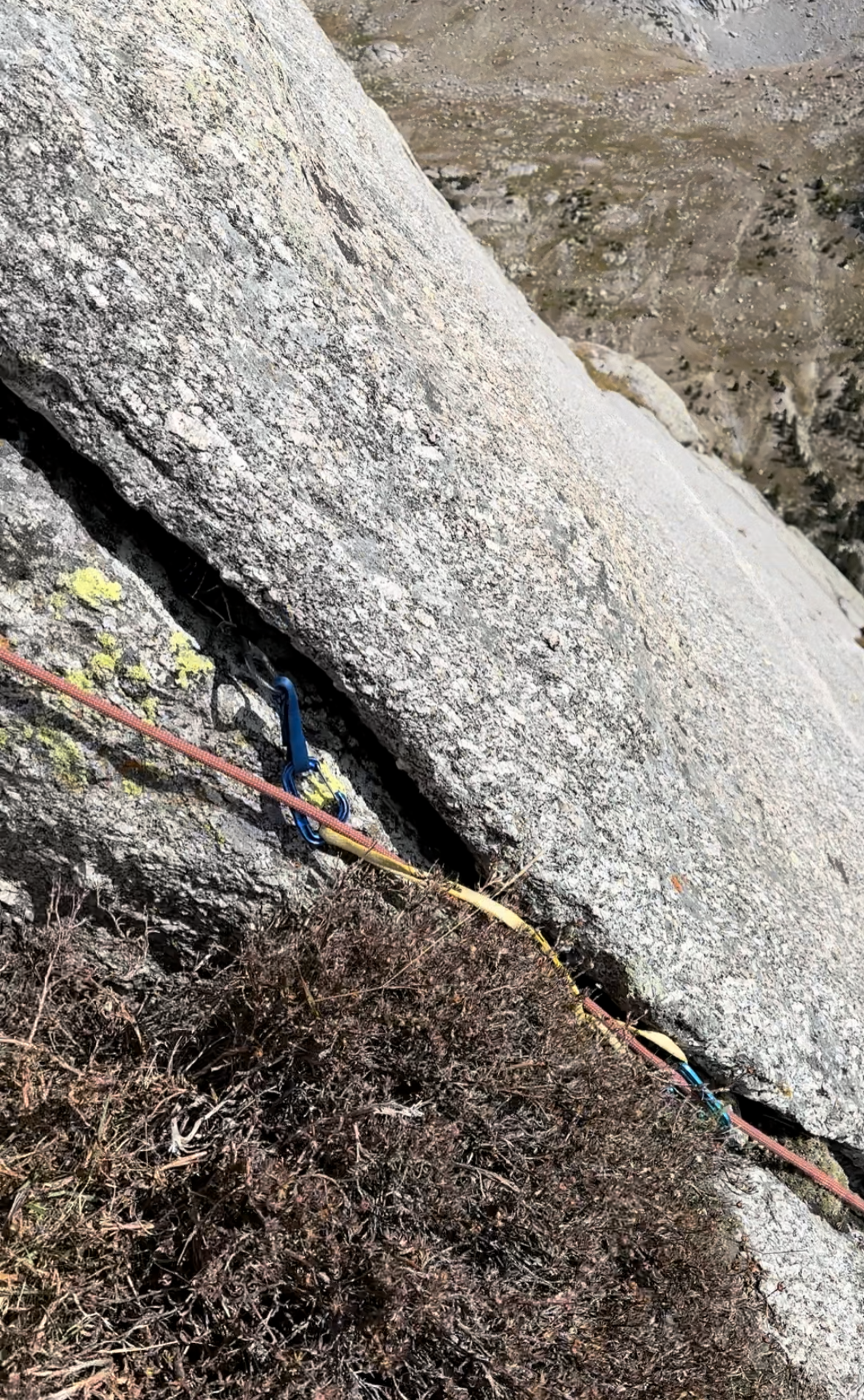
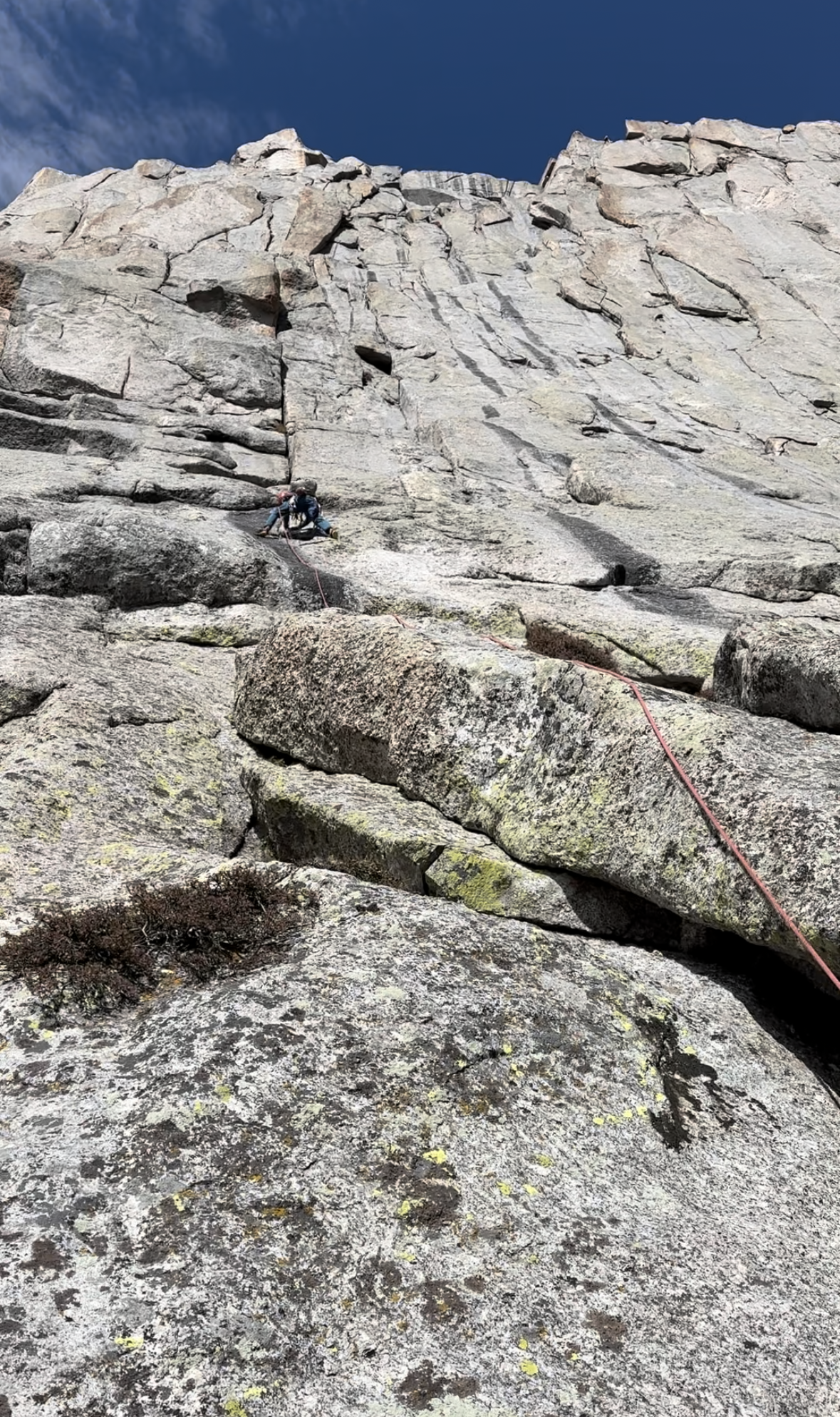
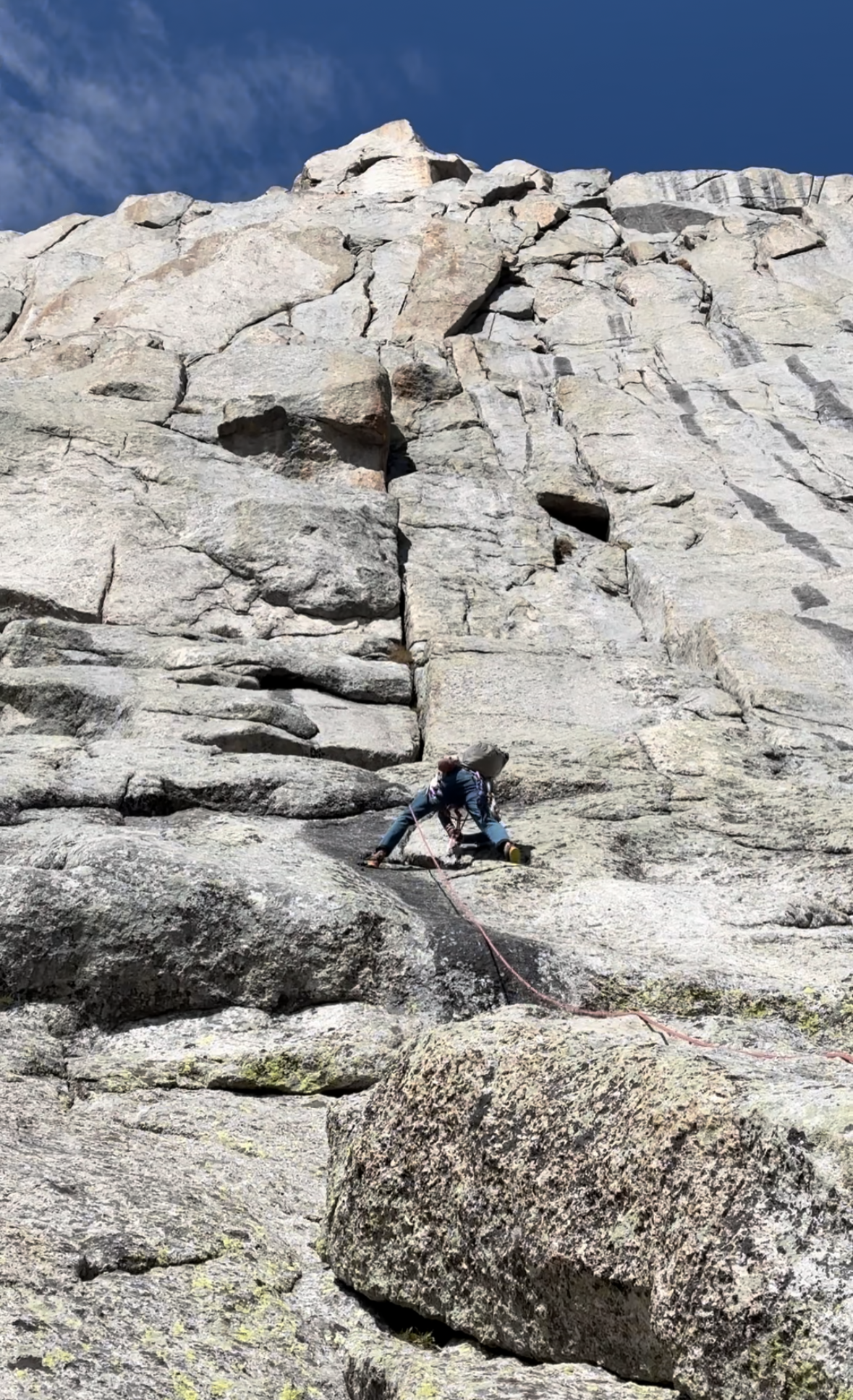
Connor starting pitch 8
Pitch 9 (5.7 | 35m | 55min)
At ~12:30pm, we transitioned for pitch 9. A Pika scurried across the low-5th class ledges beneath us. I wondered how it'd survive a winter on the barren East Face. Our pace slowed, the sun shifted to the South Buttress and wind picked up. I added a fleece.
Connor unclipped his PAS and started up the crack system, finishing with a mantle to reach a ledge system above a roof. Rope drag weighed him down. He slung a horn and placed a back-up cam, then I followed.


Anchor at the top of pitch 9, looking up at pitch 10 (left), and looking down on pitch 9 (right)
Pitch 10 (5.7 | 40m | 1hr 15min)
By 1:20pm, we looked up at pitch 10, the crux of the route from reports. At 1:25pm, Connor started climbing.
Our forearms were pumped and toes tender. Connor led pitch 10 slower than the other pitches. He was out of view and I checked in a couple times over the Rocky Talkies. In the crux crack referred to as "Glorious Hands," Connor depleted most of our double rack.
At 2pm, Connor set the anchor and I climbed. It took ~20 minutes to clear the first 2 cracks, longer than any of the prior pitches in their entirety. Each crack was ~80 degrees with few footholds. (As a crack rookie, my toe jams aren't great.)
At 2:20pm, I started the final sustained crack, maybe 5m of vertical finger crack with smooth rock on either side of the corner. Not trusting my toe jams, I opted for lie backs, making it up in 10 minutes.
Connor in sight, I fought up a final shorter crack. After 10 pitches, I had it with cracks. I started counting down meters to the summit.



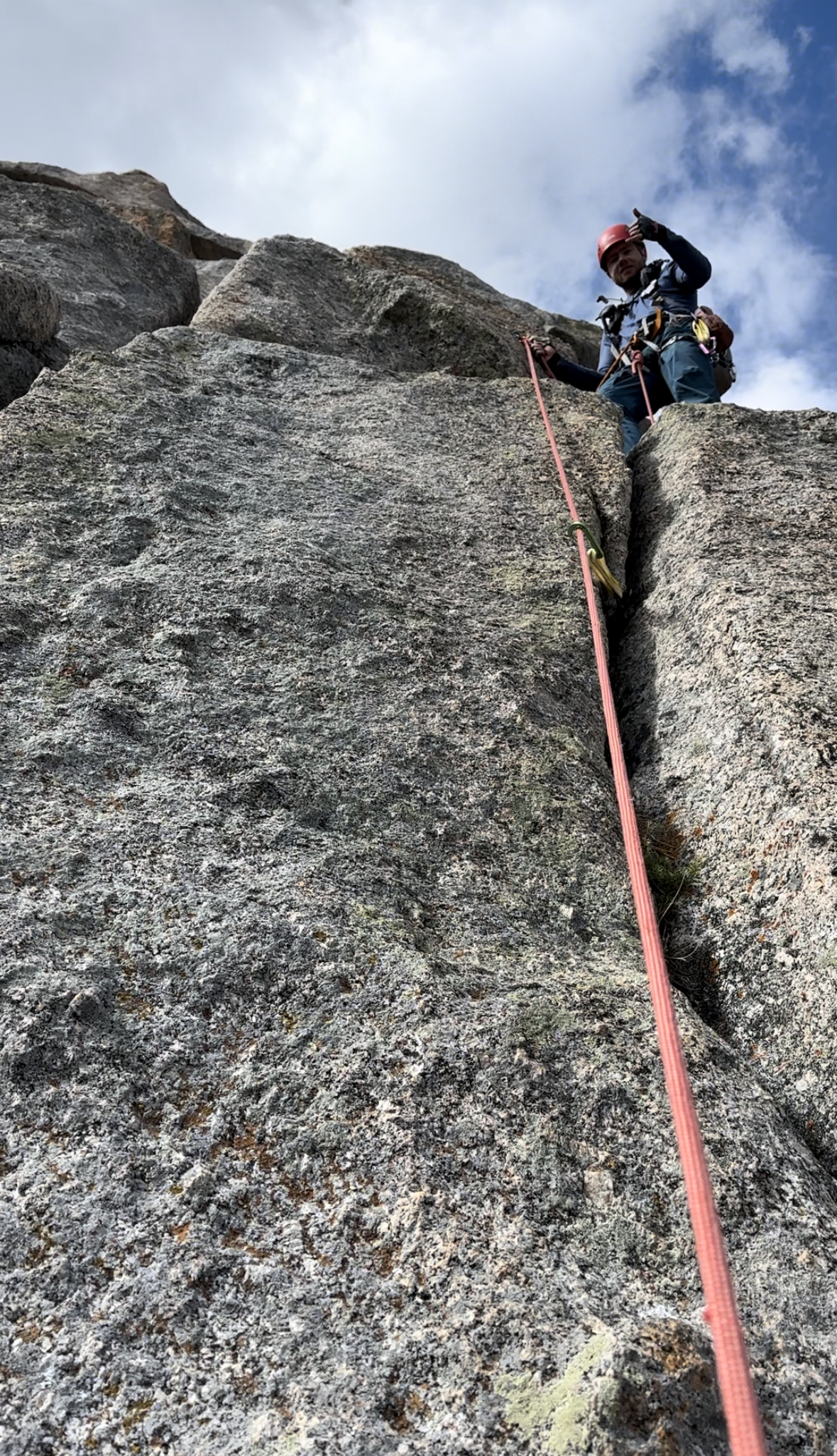
Pumped on pitch 10
Pitch 11 (5.7 | 30m | 50min)
I transferred cams to Connor, almost our whole double rack on my gear loops. We were relieved to have the crux pitch behind us. But, pitch 11 was still a 5.7.
Connor started pitch 11 at 2:40pm. He finished the final 30m in 30 minutes, again mostly out of sight. I followed in 20 minutes, cursing each crack along the way. I shook out my arms, but struggled to recover from forearm pump.
At 3:30pm, I completed the final pull-up below Connor's anchor and felt the relief of low 5th class ahead. To reinforce a few worn slings around a horn above the ledge, Connor placed two back-up cams.
Our ledge overhung the wall. I could see the boulders, home to our morning pika, ~1,300' below. Lonesome Lake glistened in the afternoon sun.
Clearing the 5.7s, we ditched climbers for approach shoes. Each time we transitioned, I half expected my climbing shoes to fall off the edge. Memory of Brigette's shoe tumbling down CMC Face was fresh in my mind.
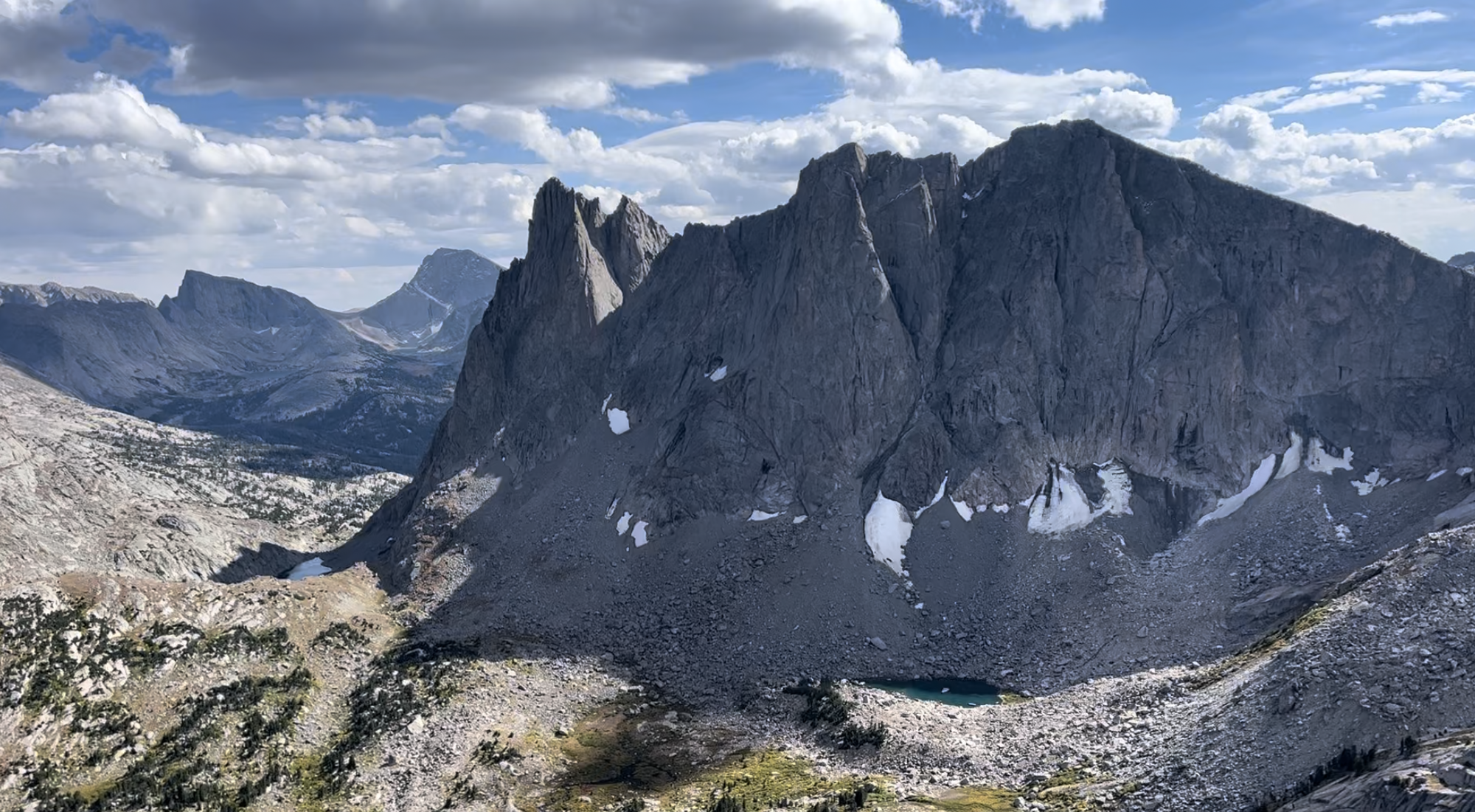
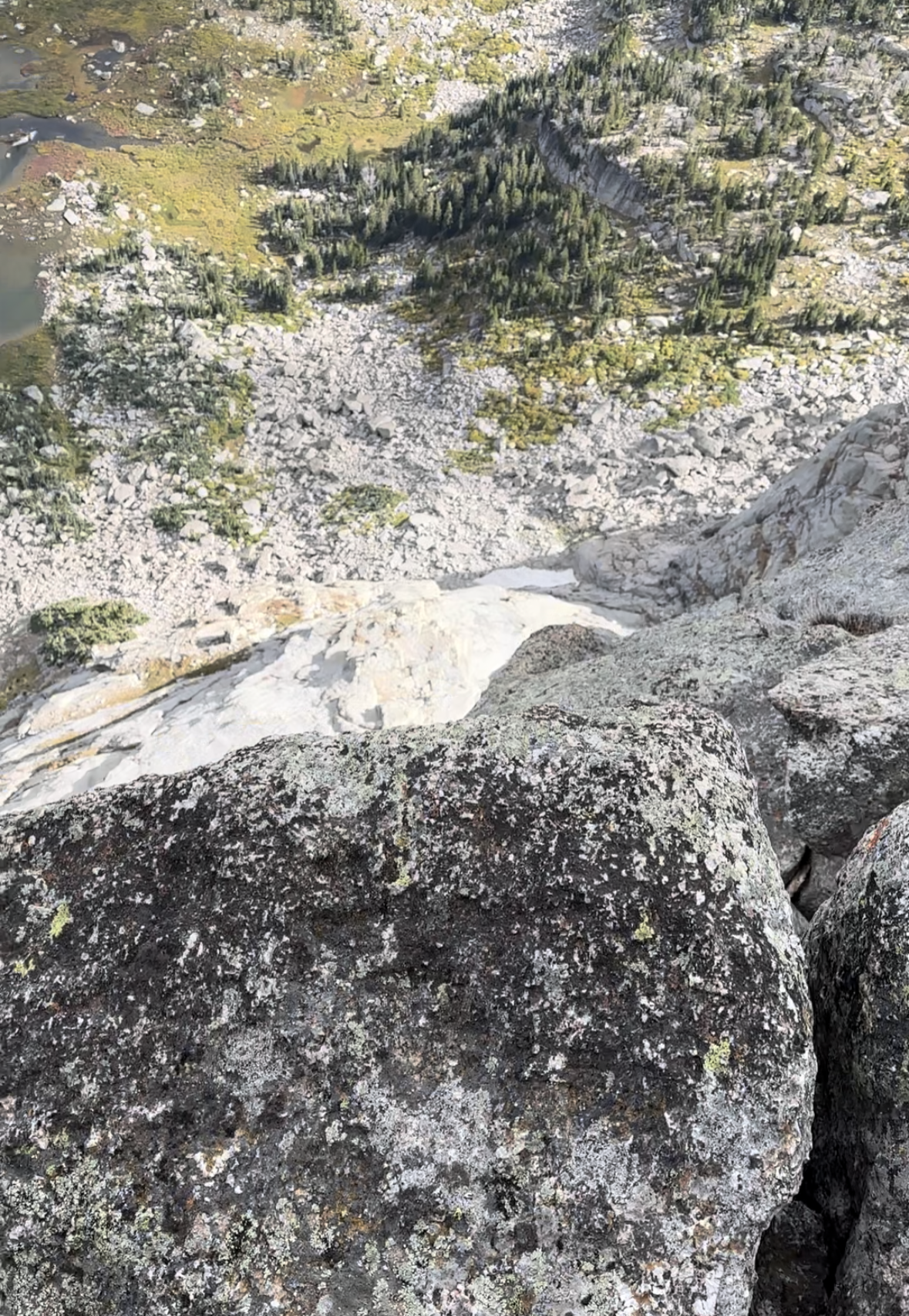
Views from the top of pitch 11
Final scramble (4th to low 5th class)
We decided to stay roped for the final low-5th class climbing. I didn't trust my grip and we played it safe. We climbed the remaining 15m in 15 minutes, then butterfly coiled the single rope and 4th-class scrambled south to the summit.
Along the way, we passed a 5-star bivy site, 50ft north of the summit. At the top of Pingora, we looked west to Cirque of the Towers, south to Jackass Pass and east to the valley of our misadventure a ~week prior.
I ditched crack for crag gloves to rappel. I reached for the Goldfish that survived a 2am mouse heist. (Flavor-blasted pepper jack.) As I pulled the bag's seams, my forearms cramped, pointer fingers into my palms. I drank the remaining electrolyte mix, hoping to buy time.




Final scramble and summit views (Cirque of the Towers)
Back to the Bivy Boulder
After 20 minutes at the summit, we retraced our steps north, turning right to descend a gully to the South Buttress.
Brief snow flurries fell. The sunny morning yielded to broken clouds in the afternoon. They thickened, but didn't look menacing.
After ~10 minutes, we found the first 2-bolt rappel anchor. Connor lowered himself to the ledge, clipped his PAS into a bolt and started flaking the 60m single rope. I followed suit with the 60m half rope.
By 4:20pm, Connor dropped over the edge, untangling ropes at a ledge ~30m down the face. At 4:30pm, I followed, calling out a reminder to "pull blue."
We stretched the ropes to reach the third rappel station, skipping a second set of bolts. At the third station, I clipped my PAS into a bolt, then climbed up a couple feet to release some tension in the ropes. Still taut, I un-knotted the red single rope, pushed it through my ATC and pulled on the blue half rope. I released my ATC once we got slack in the half rope.
I pulled as Connor threaded the half rope through the anchor. Then, my forearms cramped. Connor took over. I helped as much as my forearms allowed. The single rope tumbled down. We finished setting up, then dropped.




1st rappel (top / bottom left); looking up at the South Buttress from below the 2nd rappel (bottom right)
By 5pm, the ropes were butterfly coiled on a ledge beneath the South Buttress. I took the single rope, since Connor carried most of the cams. We started hiking east toward the south shoulder, then followed cairns to a southwest ledge system. We navigated class 3-4 rock and trails, debating the route a couple times when the path seemed to split.



Navigating ledges to and below the south shoulder
After 15 minutes, we reached the valley trail, turning south toward camp. At 5:30pm, we passed the granite dam from the sunrise shot and looked back at Pingora. We now knew we could handle an 11-pitch day, at least up to 5.7, a big step forward from summer 2022.
We reached our boulder, relieved to find bivy gear mouse-free. We shed harnesses and layers. I kept my base layer top, but ditched the bottoms.





Hiking back to the bivy boulder
After 20min of packing, fueling and hydrating, we hoisted our full(er) packs on our shoulders and started for Jackass Pass.
Racing the Rain to Big Sandy
I got to see Arrowhead and North Lakes on the exit. On approach Sunday night, we navigated pitch-black boulder fields and trails. Connor alluded to lakes below, but I hadn't seen them until now.
We passed a couple groups near Jackass Pass. We hadn't seen anyone since the morning. Solitude on Pingora. On approach, we felt nervous about 11 pitches, unsure if we'd be derailed again. On exit, we were giddy. We joked that, at least by our standards, the day went too smoothly. We half expected a grizzly to charge.
Connor and I tend to push our limits with objectives, so there's usually a twist. Bailing on the Skillet 1,000' from the summit, skinning through a snowstorm on Jackson Lake in the dark; on CMC Face, climbing Drizzlepuss, the crux, at night; our recent turnaround in the Winds – to name a few.
At 7:15pm, we reached the north side of Big Sandy Lake. We saw an animal swimming in the lake. Maybe a muskrat? Seemed small for a beaver.



Hike from Jackass Pass to Big Sandy Lake
We passed a few campers and hikers along Big Sandy. At ~7:30pm, passing the south end of the lake, we jogged. The sun set and we hoped to beat rain showers forecast that night. After 3 miles, my knees felt the impact of my 40lb pack. I popped a couple more ibuprofen at camp before the exit hike, which helped.
A handful of downloaded songs played from my phone speakers, as we paced 15min miles to the trailhead.
At 8:30pm, we saw headlights, then the trailhead map. I dug for my keys, opened the tailgate and tossed my pack and rope on the truck bed. I swapped approach shoes for flip-flops, cracked my reserve cold brew and gorged on the extra Goldfish (pizza flavored).



Final exit jog and fuel for the drive to Pinedale
At 8:40pm, we hit the road. The access roads from the Big Sandy Trailhead to Boulder stretched on and on. Another moonless night. The dirt access road was rutted after a wet summer.
By 10pm, we reached Ridley's in Pinedale for real toilets and more snacks, rummaging through some eclectic warm dishes. Connor picked clam chowder, one of the better options believe it or not.
Blink-182 and Offspring powered the final hour and a half to Jackson, pulling in front of my house by midnight. We saved unpacking for Tuesday.